- Associations


Word Association Lookup
The project «Word Associations Network» gives you an opportunity to lookup associations with a given word. Word associations arise in the human’s mind when reading or saying a word, or just thinking about the word. In order to retrieve the list of associations to a word, just type in the word in the search panel and press <Enter> key or "Search" button.
It is also possible to search for a word by the first letter. Click the desired letter on the navigation pane, and you will pass to a page containing a list of words, which start with the given letter.
If the results you are looking for are not on the first page of search results, you can click "Next" and "Previous" at the bottom of the page to see more results.
For better usability each word is accompanied by the explanatory articles from WordNet lexical database. The search results can also contain images, which depict the meaning of corresponding word. Click on the selected image in order to see it in higher resolution.
The Description of the Project
"Word Associations Network" is inherently an ideographic dictionary or thesaurus. The project consists of three basic components: an associative dictionary, an explanatory dictionary, and a picture dictionary. The associative dictionary, the dictionary of associations, or analogical dictionary groups the words of the language by psychological perception, sense and meaning. The explanatory dictionary provides lexical meaning for every word. This dictionary often provides examples on the usage of a word. Picture vocabulary or visual dictionary contains graphic illustrations that depict the meaning of words.
The Definition of Word Association
Association is one of the basic mechanisms of memory. In a sense, they can be called natural classifiers of the conceptual content of the vocabulary of the language. Ideas and concepts, which are available to the memory of a man are related. This relationship is based on the past experience of a man and, in the final analysis, more or less accurately reproduces objectively existing relationship between the phenomena of the real world. Under certain conditions, a revival of one idea or concept is accompanied by a revival of others ideas correlated with it. This phenomenon is called the association (a term proposed in the XVIII century by Locke).
Classification of Associations
Since Aristotle the people distinguish association by similarity, contrast and contiguity.
Association by similarity is based on the fact that the associated phenomena have some common features. It represents a result of generalization of the conditioned connection in which similar stimuli evoke similar reactions (for example, excitement of synonymic series with actualization of one of the synonyms: woe - unhappiness, sorrow, grief, sadness, and so on).
Close to the association by similarity is association by contrast, the origin of which is explained by the presence in phenomena of opposite features. The physiological nature of the association by contrast is in the "mutual induction of neural processes when strong stimuli ... cause great excitement in the beginning, and then successive inhibition in the same regions of the cerebral cortex. As a result, in the future one of the contrasting stimuli can cause immediately after it something that was caused before by another stimulus (contrast with given one)" (for example, the phenomenon of antonyms: grief - joy, happiness – unhappiness, and so on).
Association by contiguity comes into existence when events are situated close together in time or space. Currently, the three mentioned types of associations are classified as simple or mechanical. Along with them, more complex semantic association is distinguished. This is, in particular, the association reflecting generic and cause-and-effect relationship between the objects of the world (for example, a flower - a rose, a disease - death, and so on).
The Role of Associations
Since the associations reflect some significant relations between objects and phenomena of the real world, and thus between the concepts, it is reasonable to conclude that they play an important role in the structure of the lexical system of the language. This was pointed out as long ago as by N.V. Krushevskiy: "Every word is linked to other words by ties of association by similarity; this similarity will not be only external, i.e. sound or structural, morphological, but also internal, semasiological. Or in other words: every word is capable, due to a special mental law, to bring in our mind other words with which it is similar, and is excited by these words ..."
"journey" statistics
statistical information is copyright © 2003-2024 wordassociation.org
- Search Menu
- Browse content in Arts and Humanities
- Browse content in Archaeology
- Anglo-Saxon and Medieval Archaeology
- Archaeological Methodology and Techniques
- Archaeology by Region
- Archaeology of Religion
- Archaeology of Trade and Exchange
- Biblical Archaeology
- Contemporary and Public Archaeology
- Environmental Archaeology
- Historical Archaeology
- History and Theory of Archaeology
- Industrial Archaeology
- Landscape Archaeology
- Mortuary Archaeology
- Prehistoric Archaeology
- Underwater Archaeology
- Urban Archaeology
- Zooarchaeology
- Browse content in Architecture
- Architectural Structure and Design
- History of Architecture
- Residential and Domestic Buildings
- Theory of Architecture
- Browse content in Art
- Art Subjects and Themes
- History of Art
- Industrial and Commercial Art
- Theory of Art
- Biographical Studies
- Byzantine Studies
- Browse content in Classical Studies
- Classical History
- Classical Philosophy
- Classical Mythology
- Classical Literature
- Classical Reception
- Classical Art and Architecture
- Classical Oratory and Rhetoric
- Greek and Roman Papyrology
- Greek and Roman Epigraphy
- Greek and Roman Law
- Greek and Roman Archaeology
- Late Antiquity
- Religion in the Ancient World
- Digital Humanities
- Browse content in History
- Colonialism and Imperialism
- Diplomatic History
- Environmental History
- Genealogy, Heraldry, Names, and Honours
- Genocide and Ethnic Cleansing
- Historical Geography
- History by Period
- History of Emotions
- History of Agriculture
- History of Education
- History of Gender and Sexuality
- Industrial History
- Intellectual History
- International History
- Labour History
- Legal and Constitutional History
- Local and Family History
- Maritime History
- Military History
- National Liberation and Post-Colonialism
- Oral History
- Political History
- Public History
- Regional and National History
- Revolutions and Rebellions
- Slavery and Abolition of Slavery
- Social and Cultural History
- Theory, Methods, and Historiography
- Urban History
- World History
- Browse content in Language Teaching and Learning
- Language Learning (Specific Skills)
- Language Teaching Theory and Methods
- Browse content in Linguistics
- Applied Linguistics
- Cognitive Linguistics
- Computational Linguistics
- Forensic Linguistics
- Grammar, Syntax and Morphology
- Historical and Diachronic Linguistics
- History of English
- Language Evolution
- Language Reference
- Language Acquisition
- Language Variation
- Language Families
- Lexicography
- Linguistic Anthropology
- Linguistic Theories
- Linguistic Typology
- Phonetics and Phonology
- Psycholinguistics
- Sociolinguistics
- Translation and Interpretation
- Writing Systems
- Browse content in Literature
- Bibliography
- Children's Literature Studies
- Literary Studies (Romanticism)
- Literary Studies (American)
- Literary Studies (Asian)
- Literary Studies (European)
- Literary Studies (Eco-criticism)
- Literary Studies (Modernism)
- Literary Studies - World
- Literary Studies (1500 to 1800)
- Literary Studies (19th Century)
- Literary Studies (20th Century onwards)
- Literary Studies (African American Literature)
- Literary Studies (British and Irish)
- Literary Studies (Early and Medieval)
- Literary Studies (Fiction, Novelists, and Prose Writers)
- Literary Studies (Gender Studies)
- Literary Studies (Graphic Novels)
- Literary Studies (History of the Book)
- Literary Studies (Plays and Playwrights)
- Literary Studies (Poetry and Poets)
- Literary Studies (Postcolonial Literature)
- Literary Studies (Queer Studies)
- Literary Studies (Science Fiction)
- Literary Studies (Travel Literature)
- Literary Studies (War Literature)
- Literary Studies (Women's Writing)
- Literary Theory and Cultural Studies
- Mythology and Folklore
- Shakespeare Studies and Criticism
- Browse content in Media Studies
- Browse content in Music
- Applied Music
- Dance and Music
- Ethics in Music
- Ethnomusicology
- Gender and Sexuality in Music
- Medicine and Music
- Music Cultures
- Music and Media
- Music and Religion
- Music and Culture
- Music Education and Pedagogy
- Music Theory and Analysis
- Musical Scores, Lyrics, and Libretti
- Musical Structures, Styles, and Techniques
- Musicology and Music History
- Performance Practice and Studies
- Race and Ethnicity in Music
- Sound Studies
- Browse content in Performing Arts
- Browse content in Philosophy
- Aesthetics and Philosophy of Art
- Epistemology
- Feminist Philosophy
- History of Western Philosophy
- Metaphysics
- Moral Philosophy
- Non-Western Philosophy
- Philosophy of Language
- Philosophy of Mind
- Philosophy of Perception
- Philosophy of Science
- Philosophy of Action
- Philosophy of Law
- Philosophy of Religion
- Philosophy of Mathematics and Logic
- Practical Ethics
- Social and Political Philosophy
- Browse content in Religion
- Biblical Studies
- Christianity
- East Asian Religions
- History of Religion
- Judaism and Jewish Studies
- Qumran Studies
- Religion and Education
- Religion and Health
- Religion and Politics
- Religion and Science
- Religion and Law
- Religion and Art, Literature, and Music
- Religious Studies
- Browse content in Society and Culture
- Cookery, Food, and Drink
- Cultural Studies
- Customs and Traditions
- Ethical Issues and Debates
- Hobbies, Games, Arts and Crafts
- Lifestyle, Home, and Garden
- Natural world, Country Life, and Pets
- Popular Beliefs and Controversial Knowledge
- Sports and Outdoor Recreation
- Technology and Society
- Travel and Holiday
- Visual Culture
- Browse content in Law
- Arbitration
- Browse content in Company and Commercial Law
- Commercial Law
- Company Law
- Browse content in Comparative Law
- Systems of Law
- Competition Law
- Browse content in Constitutional and Administrative Law
- Government Powers
- Judicial Review
- Local Government Law
- Military and Defence Law
- Parliamentary and Legislative Practice
- Construction Law
- Contract Law
- Browse content in Criminal Law
- Criminal Procedure
- Criminal Evidence Law
- Sentencing and Punishment
- Employment and Labour Law
- Environment and Energy Law
- Browse content in Financial Law
- Banking Law
- Insolvency Law
- History of Law
- Human Rights and Immigration
- Intellectual Property Law
- Browse content in International Law
- Private International Law and Conflict of Laws
- Public International Law
- IT and Communications Law
- Jurisprudence and Philosophy of Law
- Law and Politics
- Law and Society
- Browse content in Legal System and Practice
- Courts and Procedure
- Legal Skills and Practice
- Primary Sources of Law
- Regulation of Legal Profession
- Medical and Healthcare Law
- Browse content in Policing
- Criminal Investigation and Detection
- Police and Security Services
- Police Procedure and Law
- Police Regional Planning
- Browse content in Property Law
- Personal Property Law
- Study and Revision
- Terrorism and National Security Law
- Browse content in Trusts Law
- Wills and Probate or Succession
- Browse content in Medicine and Health
- Browse content in Allied Health Professions
- Arts Therapies
- Clinical Science
- Dietetics and Nutrition
- Occupational Therapy
- Operating Department Practice
- Physiotherapy
- Radiography
- Speech and Language Therapy
- Browse content in Anaesthetics
- General Anaesthesia
- Neuroanaesthesia
- Clinical Neuroscience
- Browse content in Clinical Medicine
- Acute Medicine
- Cardiovascular Medicine
- Clinical Genetics
- Clinical Pharmacology and Therapeutics
- Dermatology
- Endocrinology and Diabetes
- Gastroenterology
- Genito-urinary Medicine
- Geriatric Medicine
- Infectious Diseases
- Medical Toxicology
- Medical Oncology
- Pain Medicine
- Palliative Medicine
- Rehabilitation Medicine
- Respiratory Medicine and Pulmonology
- Rheumatology
- Sleep Medicine
- Sports and Exercise Medicine
- Community Medical Services
- Critical Care
- Emergency Medicine
- Forensic Medicine
- Haematology
- History of Medicine
- Browse content in Medical Skills
- Clinical Skills
- Communication Skills
- Nursing Skills
- Surgical Skills
- Browse content in Medical Dentistry
- Oral and Maxillofacial Surgery
- Paediatric Dentistry
- Restorative Dentistry and Orthodontics
- Surgical Dentistry
- Medical Ethics
- Medical Statistics and Methodology
- Browse content in Neurology
- Clinical Neurophysiology
- Neuropathology
- Nursing Studies
- Browse content in Obstetrics and Gynaecology
- Gynaecology
- Occupational Medicine
- Ophthalmology
- Otolaryngology (ENT)
- Browse content in Paediatrics
- Neonatology
- Browse content in Pathology
- Chemical Pathology
- Clinical Cytogenetics and Molecular Genetics
- Histopathology
- Medical Microbiology and Virology
- Patient Education and Information
- Browse content in Pharmacology
- Psychopharmacology
- Browse content in Popular Health
- Caring for Others
- Complementary and Alternative Medicine
- Self-help and Personal Development
- Browse content in Preclinical Medicine
- Cell Biology
- Molecular Biology and Genetics
- Reproduction, Growth and Development
- Primary Care
- Professional Development in Medicine
- Browse content in Psychiatry
- Addiction Medicine
- Child and Adolescent Psychiatry
- Forensic Psychiatry
- Learning Disabilities
- Old Age Psychiatry
- Psychotherapy
- Browse content in Public Health and Epidemiology
- Epidemiology
- Public Health
- Browse content in Radiology
- Clinical Radiology
- Interventional Radiology
- Nuclear Medicine
- Radiation Oncology
- Reproductive Medicine
- Browse content in Surgery
- Cardiothoracic Surgery
- Gastro-intestinal and Colorectal Surgery
- General Surgery
- Neurosurgery
- Paediatric Surgery
- Peri-operative Care
- Plastic and Reconstructive Surgery
- Surgical Oncology
- Transplant Surgery
- Trauma and Orthopaedic Surgery
- Vascular Surgery
- Browse content in Science and Mathematics
- Browse content in Biological Sciences
- Aquatic Biology
- Biochemistry
- Bioinformatics and Computational Biology
- Developmental Biology
- Ecology and Conservation
- Evolutionary Biology
- Genetics and Genomics
- Microbiology
- Molecular and Cell Biology
- Natural History
- Plant Sciences and Forestry
- Research Methods in Life Sciences
- Structural Biology
- Systems Biology
- Zoology and Animal Sciences
- Browse content in Chemistry
- Analytical Chemistry
- Computational Chemistry
- Crystallography
- Environmental Chemistry
- Industrial Chemistry
- Inorganic Chemistry
- Materials Chemistry
- Medicinal Chemistry
- Mineralogy and Gems
- Organic Chemistry
- Physical Chemistry
- Polymer Chemistry
- Study and Communication Skills in Chemistry
- Theoretical Chemistry
- Browse content in Computer Science
- Artificial Intelligence
- Computer Architecture and Logic Design
- Game Studies
- Human-Computer Interaction
- Mathematical Theory of Computation
- Programming Languages
- Software Engineering
- Systems Analysis and Design
- Virtual Reality
- Browse content in Computing
- Business Applications
- Computer Security
- Computer Games
- Computer Networking and Communications
- Digital Lifestyle
- Graphical and Digital Media Applications
- Operating Systems
- Browse content in Earth Sciences and Geography
- Atmospheric Sciences
- Environmental Geography
- Geology and the Lithosphere
- Maps and Map-making
- Meteorology and Climatology
- Oceanography and Hydrology
- Palaeontology
- Physical Geography and Topography
- Regional Geography
- Soil Science
- Urban Geography
- Browse content in Engineering and Technology
- Agriculture and Farming
- Biological Engineering
- Civil Engineering, Surveying, and Building
- Electronics and Communications Engineering
- Energy Technology
- Engineering (General)
- Environmental Science, Engineering, and Technology
- History of Engineering and Technology
- Mechanical Engineering and Materials
- Technology of Industrial Chemistry
- Transport Technology and Trades
- Browse content in Environmental Science
- Applied Ecology (Environmental Science)
- Conservation of the Environment (Environmental Science)
- Environmental Sustainability
- Environmentalist Thought and Ideology (Environmental Science)
- Management of Land and Natural Resources (Environmental Science)
- Natural Disasters (Environmental Science)
- Nuclear Issues (Environmental Science)
- Pollution and Threats to the Environment (Environmental Science)
- Social Impact of Environmental Issues (Environmental Science)
- History of Science and Technology
- Browse content in Materials Science
- Ceramics and Glasses
- Composite Materials
- Metals, Alloying, and Corrosion
- Nanotechnology
- Browse content in Mathematics
- Applied Mathematics
- Biomathematics and Statistics
- History of Mathematics
- Mathematical Education
- Mathematical Finance
- Mathematical Analysis
- Numerical and Computational Mathematics
- Probability and Statistics
- Pure Mathematics
- Browse content in Neuroscience
- Cognition and Behavioural Neuroscience
- Development of the Nervous System
- Disorders of the Nervous System
- History of Neuroscience
- Invertebrate Neurobiology
- Molecular and Cellular Systems
- Neuroendocrinology and Autonomic Nervous System
- Neuroscientific Techniques
- Sensory and Motor Systems
- Browse content in Physics
- Astronomy and Astrophysics
- Atomic, Molecular, and Optical Physics
- Biological and Medical Physics
- Classical Mechanics
- Computational Physics
- Condensed Matter Physics
- Electromagnetism, Optics, and Acoustics
- History of Physics
- Mathematical and Statistical Physics
- Measurement Science
- Nuclear Physics
- Particles and Fields
- Plasma Physics
- Quantum Physics
- Relativity and Gravitation
- Semiconductor and Mesoscopic Physics
- Browse content in Psychology
- Affective Sciences
- Clinical Psychology
- Cognitive Psychology
- Cognitive Neuroscience
- Criminal and Forensic Psychology
- Developmental Psychology
- Educational Psychology
- Evolutionary Psychology
- Health Psychology
- History and Systems in Psychology
- Music Psychology
- Neuropsychology
- Organizational Psychology
- Psychological Assessment and Testing
- Psychology of Human-Technology Interaction
- Psychology Professional Development and Training
- Research Methods in Psychology
- Social Psychology
- Browse content in Social Sciences
- Browse content in Anthropology
- Anthropology of Religion
- Human Evolution
- Medical Anthropology
- Physical Anthropology
- Regional Anthropology
- Social and Cultural Anthropology
- Theory and Practice of Anthropology
- Browse content in Business and Management
- Business Ethics
- Business Strategy
- Business History
- Business and Technology
- Business and Government
- Business and the Environment
- Comparative Management
- Corporate Governance
- Corporate Social Responsibility
- Entrepreneurship
- Health Management
- Human Resource Management
- Industrial and Employment Relations
- Industry Studies
- Information and Communication Technologies
- International Business
- Knowledge Management
- Management and Management Techniques
- Operations Management
- Organizational Theory and Behaviour
- Pensions and Pension Management
- Public and Nonprofit Management
- Strategic Management
- Supply Chain Management
- Browse content in Criminology and Criminal Justice
- Criminal Justice
- Criminology
- Forms of Crime
- International and Comparative Criminology
- Youth Violence and Juvenile Justice
- Development Studies
- Browse content in Economics
- Agricultural, Environmental, and Natural Resource Economics
- Asian Economics
- Behavioural Finance
- Behavioural Economics and Neuroeconomics
- Econometrics and Mathematical Economics
- Economic History
- Economic Systems
- Economic Methodology
- Economic Development and Growth
- Financial Markets
- Financial Institutions and Services
- General Economics and Teaching
- Health, Education, and Welfare
- History of Economic Thought
- International Economics
- Labour and Demographic Economics
- Law and Economics
- Macroeconomics and Monetary Economics
- Microeconomics
- Public Economics
- Urban, Rural, and Regional Economics
- Welfare Economics
- Browse content in Education
- Adult Education and Continuous Learning
- Care and Counselling of Students
- Early Childhood and Elementary Education
- Educational Equipment and Technology
- Educational Strategies and Policy
- Higher and Further Education
- Organization and Management of Education
- Philosophy and Theory of Education
- Schools Studies
- Secondary Education
- Teaching of a Specific Subject
- Teaching of Specific Groups and Special Educational Needs
- Teaching Skills and Techniques
- Browse content in Environment
- Applied Ecology (Social Science)
- Climate Change
- Conservation of the Environment (Social Science)
- Environmentalist Thought and Ideology (Social Science)
- Natural Disasters (Environment)
- Social Impact of Environmental Issues (Social Science)
- Browse content in Human Geography
- Cultural Geography
- Economic Geography
- Political Geography
- Browse content in Interdisciplinary Studies
- Communication Studies
- Museums, Libraries, and Information Sciences
- Browse content in Politics
- African Politics
- Asian Politics
- Chinese Politics
- Comparative Politics
- Conflict Politics
- Elections and Electoral Studies
- Environmental Politics
- European Union
- Foreign Policy
- Gender and Politics
- Human Rights and Politics
- Indian Politics
- International Relations
- International Organization (Politics)
- International Political Economy
- Irish Politics
- Latin American Politics
- Middle Eastern Politics
- Political Behaviour
- Political Economy
- Political Institutions
- Political Methodology
- Political Communication
- Political Philosophy
- Political Sociology
- Political Theory
- Politics and Law
- Public Policy
- Public Administration
- Quantitative Political Methodology
- Regional Political Studies
- Russian Politics
- Security Studies
- State and Local Government
- UK Politics
- US Politics
- Browse content in Regional and Area Studies
- African Studies
- Asian Studies
- East Asian Studies
- Japanese Studies
- Latin American Studies
- Middle Eastern Studies
- Native American Studies
- Scottish Studies
- Browse content in Research and Information
- Research Methods
- Browse content in Social Work
- Addictions and Substance Misuse
- Adoption and Fostering
- Care of the Elderly
- Child and Adolescent Social Work
- Couple and Family Social Work
- Developmental and Physical Disabilities Social Work
- Direct Practice and Clinical Social Work
- Emergency Services
- Human Behaviour and the Social Environment
- International and Global Issues in Social Work
- Mental and Behavioural Health
- Social Justice and Human Rights
- Social Policy and Advocacy
- Social Work and Crime and Justice
- Social Work Macro Practice
- Social Work Practice Settings
- Social Work Research and Evidence-based Practice
- Welfare and Benefit Systems
- Browse content in Sociology
- Childhood Studies
- Community Development
- Comparative and Historical Sociology
- Economic Sociology
- Gender and Sexuality
- Gerontology and Ageing
- Health, Illness, and Medicine
- Marriage and the Family
- Migration Studies
- Occupations, Professions, and Work
- Organizations
- Population and Demography
- Race and Ethnicity
- Social Theory
- Social Movements and Social Change
- Social Research and Statistics
- Social Stratification, Inequality, and Mobility
- Sociology of Religion
- Sociology of Education
- Sport and Leisure
- Urban and Rural Studies
- Browse content in Warfare and Defence
- Defence Strategy, Planning, and Research
- Land Forces and Warfare
- Military Administration
- Military Life and Institutions
- Naval Forces and Warfare
- Other Warfare and Defence Issues
- Peace Studies and Conflict Resolution
- Weapons and Equipment

- < Previous chapter
- Next chapter >

26 Word Associations
Simon De Deyne, University of Leuven, Belgium
Gert Storms, Laboratory for Experimental Psychology, University of Leuven, Belgium
- Published: 03 March 2014
- Cite Icon Cite
- Permissions Icon Permissions
Word associations have been the topic of intensive study in psychology as they offer one of the most direct ways to learn about the mental lexicon. This chapter provides an overview of the role of word associations in psycholinguistic research. The first part explains what associative responses are, how they relate to lexical contiguities derived from language, and how recent developments have made possible the representation of the mental lexicon as a network using large association data sets. The second part discusses the implications of this network, concentrating on how lexical availability enhances word processing. This is followed by a discussion of new developments regarding the study of the global structure of large word association networks as they grow over time, and of lexical search and retrieval through the process of spreading activation. The chapter concludes with some suggestions for future directions.
26.1 Introduction
The word association task is one of the most archetypical experiments in psychology. In a typical word association task, a person is asked to write down the first word(s) that spontaneously come to mind after reading a cue word. This straightforward task is referred to as a free association task, since no restrictions are imposed on the type of answers that are produced. In this sense it is different from related procedures such as verbal fluency tasks, in which one must, for example, name as many animals or words beginning with a given letter as possible.
For over a century, psychologists and psychiatrists like Galton (1880) and Bleuler (1911 /1950) have been fascinated by the way word associations offer a window on structures and processes in the human mind. Even today, the word association task remains an influential tool in cognitive science for the same reasons.
While the basic experimental paradigm has not changed much, the implications, usage, and understanding of the word association task has changed significantly throughout its history. Many of these changes reflect the evolution of the last decades, such as advances in neuro-imaging and electrophysiological techniques, further theoretical developments in network theory, and the availability of large amounts of data and massive computational power. A first surge in the study of word associations reflected the prevalent behaviourist ideas of the time by focusing on the notion of direct association strength, where associations represented a conditioned language response to a verbal cue. This associative strength reflects the fact that most people give similar responses in a word association task. For example, when they are presented the cue word hammer , the associate response nails is given by almost half of all participants and with twice the probability of the response wood . The notion of strength is still important in explanations of several psychological phenomena such as our ability to recall words from episodic memory. A frequently used paradigm to test how associative strength affects the ease of recall is the cued recall task (for an overview see Nelson, Schreiber, and McEvoy 1992 ) . In this task participants are asked to memorize a list of words and are later asked to recall as many words as possible in response to an associated cue. For example, the success of recalling the studied word cork when presented with the cue bottle will depend on the associative strength between these words ( Nelson and Bajo 1985 ). Associative strength is also central to semantic priming, a phenomenon where recognizing a target word (e.g. butter ) is enhanced by an earlier presented cue word, or prime, that is strongly related (e.g. bread ) in contrast to a weakly related one (e.g. jam ). In most cases, the target is recognized or named faster, and the magnitude of this effect depends on the strength of the relationship between prime and target; this can be expressed by the number of associates they share (see Lucas 2000 for a detailed discussion).
From the 1960s researchers proposed that the focus on associative strength between isolated word pairs was not suited for the study of the meanings of words. Especially the work by Deese indicated a radical departure from a narrow view on word associations based on strength between single pairs of words ( Deese 1965 ; Szalay and Deese 1978 ). According to this new approach, the central issue is not the single connection but how the meaning of a word is conveyed by the entire set of connections to the stimulus in a larger network of knowledge. This shifts the focus from stimulus–response properties, such as associative strength between two words, to their response distributions. It offers a way of quantifying how closely related two words are by looking at the commonalities between two words. In this second approach, the words blood and accident might not be directly associated, but the overlap of these words with common associations such as wound , hurt provides insight into the way they are related. This idea was initially explored in Deese’s (1965) 1 factor analytic studies on nouns and adjectives, and inspired many modern approaches to semantic memory that rely on distributional similarity, such as Latent Semantic Analysis (LSA: Landauer and Dumais 1997; Steyvers, Shiffrin, and Nelson 2004 ) and topic models ( Andrews, Vinson, and Vigliocco 2008 ). These models are founded on the notion that the meaning of a word can be derived from the context in which it is used. Since we are exposed to thousands of words every day, this context is rich, and tracking regularities in language allows us to discover a significant part of the meaning of words. The strength of these models hinges on the massive amounts of information available in co-occurrences in written and spoken language which allows the inference of meaning beyond the contexts in which a word occurs. This way, statistical techniques similar to the factor analytic studies by Deese (1965) allow us to infer that the words cosmonaut and astronaut have the same meaning, even though are not strongly associated and rarely co-occur in the same text. If they occur in a sufficiently large number of similar contexts, this is a strong indication that their meanings are related. In the case of word associations, two words will have a similar meaning not because they are associated, but because they have many associates in common. This approach has been very successful in the study of semantic similarity of words, vocabulary acquisition, and episodic and semantic priming described earlier.
Most recently, the global structure of the network has become a frontier to the field. This approach demonstrates how networks or graphs derived from association data are used to learn about the development of language and the way words are retrieved efficiently. The large networks in which related words are connected show structure that is not apparent by looking at the strength of the connection between pairs of words or the associations they share. One of the key findings is the fact that the mental lexicon is organized as a small world network, where similar words are clumped together and any word can be reached by taking only a few hops in the network ( Steyvers and Tenenbaum 2005 ; De Deyne and Storms 2008b ). Such an organization promotes the ease of retrieval of words from the lexicon and makes the network more resilient to damage.
These three lines of research correspond to a shift from local interactions between pairs of words to interactions within a subgraph (meaning derived from distributional measures) and global characteristics of the network (network topology and centrality). These three levels, reflect the microscopic, mesoscopic, and macroscopic structure in the network and represent a recurring theme useful for discussing how recent findings from word associations inform us about structure of the mental lexicon at different scales. Section 26.2 describes the large-scale word association norms that are available. Next, Section 26.3 explains how they are characterized in terms of their semantic content and how different theories account for the variety of associative responses. Not surprisingly, word associations are closely related to the language used in daily life, but there are important points of divergence that are often overlooked. These will be discussed at the end of this section.
When studying the mental lexicon 2 through word associations, we often think of it as a network where nodes are automatically activated through spreading activation. This network-based view helps us to understand many word processing advantages that underlie effects of word frequency and context variability. The last part of this Chapter (Section 26.5 ) focuses on networks derived from word associations. It starts with a discussion of how a weighted directed network can be constructed as an approximation of the mental lexicon, and considers how empirical findings of various lexical and semantic centrality effects can be explained by such a network. This section closes with a macroscopic view of the network by looking at its global properties, specifically from the perspective of how the network might change and grow over time. Using knowledge about the global network structure, this section ends with a discussion of spreading activation as a mechanism for retrieving information from the network. Especially the surge of interest from network science in other fields including psychology has led to a renewed interest in network approaches to the lexicon. In the final section we speculate on how very recent developments are likely to shape our future understanding of the mental lexicon.
26.2 Word association data sets
Before discussing the theoretical and empirical findings derived from the word association task, a short overview of the availability of norms is in place. While there is a large collection of norms available based both on normal and non-normative populations (cf. Cramer 1968 ), few studies have attempted to compile a reasonably sized approximation of a semantic network. The largest British English word association databases are the Edinburgh Associative Thesaurus (EAT: Kiss et al. 1973 ) and the Birkbeck norms ( Moss and Older 1996 ). The EAT associations consist of responses for 8,400 cues collected between 1968 and 1971 from 100 speakers, while the Birkbeck norms include 40–50 responses for a total of 2,646 cues. For American English, the University of South Florida dataset (USF: Nelson, Schreiber, and McEvoy 2004 ) describes norms based on 5,018 cues collected from the late 1970s onwards and has been used in numerous studies.
Large sets of associations (for more than 1,000 words) have also been collected in languages other than English, including Korean ( Jung, Na, and Akama 2010 ), Japanese ( Okamoto and Ishizaki 2001 ), and Dutch. Currently, the Dutch dataset represents the largest resource publicly available. It consists of 12,000 cues and more than 3 million responses ( De Deyne, Navarro, and Storms 2013 ). In contrast to previous studies in English, it uses a continued rather than discrete procedure, in which each participant gives three associates to every word on a list of cue words. In this study, new cue words are gradually added using a snowballing principle by which, starting from a small seeding set of words, new words are added based on the frequency with which they occur as responses. 3
26.3 Composition and origins of word associations
While the free association task itself is straightforward, its unconstrained nature makes it difficult at first to grasp what association responses actually tell us about the lexicon. Many accounts hinge on the intuition that word associations reflect our experience with written and spoken language in a verbal stimulus–response kind of manner. However, such a view might oversimplify matters. To understand the nature of word association responses, we can investigate the syntactic and semantic properties of the responses. The most obvious observation is that associative responses are far from homogeneous. They include clang responses ( butter – batter ) which indicate a phonological or orthographic relationship and different kinds of semantic relationships such as contrast ( man– woman, dark – bright ), coordination ( apple – pear, green – red ), near synonymy ( sour – tart ), and thematically defined relations ( hammer – nail, mouse – cheese ). The responses can also be distinguished according to whether the cue–response relationship is syntagmatic or paradigmatic. In a syntagmatic relationship ( smelly – cheese ), cue and response have a different syntactic role in a sentence and can belong to different part-of-speech classes. A syntagmatic relation need not be one that is current in normal speech, as with yellow and banana . In a paradigmatic relation ( cheese – socks ), the words have the same syntactic function in a sentence.
(a) Distribution of paradigmatic and syntagmatic responses for adjective, noun, and verb cues; (b) semantic composition of association responses.
Differences between responses depend on the individual, on the response position in continued association procedures, and on the characteristics of the cue. Clang responses, for example, often occur faster than semantically related responses, and are quite frequent with second language learners ( McCarthy 1990 ) and patient groups. Paradigmatic responses are the most common type in adults, while children until the age of 9 provide more syntagmatic responses ( Nelson 1977 ). This difference has been explained in terms of increasing word understanding, especially through reading ( Cronin 2002 ). Fig. 26.1 shows the distribution from De Deyne et al. (2008) of syntagmatic vs. paradigmatic responses over various word classes as well as a characterization of their semantic composition. Fig. 26.1(a) illustrates the dominance of paradigmatic responses for nouns and syntagmatic responses (mostly nouns) for adjectives and verbs; Fig. 26.1(b) shows the semantic distribution of the responses. Taxonomic responses include contrast, coordination mentioned earlier, but also superordinate or hypernymy ( apple – fruit ) and subordinate or hyponomy ( apple – jonagold ) responses. Entity or meronymy responses correspond to attributes or features that are part of the concept ( dog – tail ). While both entity and taxonomic responses contribute to what is often understood as the denotation of a word or the semantic content necessary for defining a concept, the most common responses in word association data are those that capture thematic relations, indicating some sort of contiguity in time and space rather than similarity in meaning. Together with introspective judgements such as sunset – nice , thematic responses indicate that the task is very sensitive to the connotation of words. Finally, many non-semantic responses indicate purely lexical information such as compounding ( water – fall ), idiomatic uses ( sour – grapes ), or rhyme ( talk – walk ). Apart from the relative importance derived from response counts, reaction times and the sequence of different responses in continued word association tasks indicate that some types of semantic information are more readily available than other types ( Barsalou et al. 2008 ; De Deyne et al. 2008b ). Taxonomic and lexicon information including clang and compounding responses in particular are more readily available than other types of responses. Learning about the types of responses using this qualitative approach offers a first way to refine semantic theories about how the mental lexicon is organized and how it interacts with other types of representation. This will now be discussed.
26.3.1 Theories of semantic memory and word associations
Word associations are part of many models of word processing, but the debate about their origin and role is still ongoing. There are at least two different points of view worth mentioning. According to one, word associations mainly reflect word co-occurrence in language. A second view acknowledges this contribution from language, but proposes that word associations reflect an additional kind of process. This process gives rise to distinct mental properties that go beyond the information captured in written or spoken text. Recent revisions of this idea describe these additional properties in terms of an embodied view (e.g. Barsalou 2008 ) which would allow a contribution of more thematic or situated sensory-dependent simulations in the process of generating word associations.
26.3.2 Word associations as a manifestation of lexical co-occurrence
One school of thought treats word associations purely as a variable to be explained. According to this view, words that frequently co-occur will become associated and consequently activate each other in the lexicon ( Spence and Owens 1990 ). As a consequence, word associations mirror the same statistical patterns as those derived from lexical co-occurrence.
Studies that compare association response frequencies with predictions from computational models using text co-occurrences show that such a relationship is indeed present ( Griffiths and Steyvers 2003 ; Hahn and Sivley 2011 ; Wettler, Rapp, and Sedlmeier 2005 ). This view is also supported by experimental findings where new word associations are added to the lexical network. In a lexical decision task, Schrijnemakers and Raaijmakers (1997) showed that associations initially established in episodic memory by simple co-occurrence activate different semantically related words from those that are already represented in the adult lexicon. However, this might not be the complete story, as results of these studies are far from univocal. The findings from word co-occurrences derived from text invariably report only a moderate correlation with association frequencies. One possible reason for the limited success is the treatment of documents as a ‘bag-of-words’ in many large-scale co-occurrence models. This ‘bag-of-words’ term indicates that only the occurrence of a word in a document or paragraph is considered. It ignores other potentially important information such as syntax, word order, or the more abstract mental representations we need to construct when interpreting a sentence (cf. Kintsch 1988 ). These limitations are confirmed by other empirical findings on how word associations are formed. For example, Prior and Bentin (2003) showed that incidental associations were formed more easily if words were presented in a sentential context than when words were presented as isolated pairs. These findings were interpreted as evidence for the integration of lexical associations during a late stage of processing in which a mental model is constructed and related to existing world knowledge.
Finally, the word association task itself poses different constraints for responses than those in ordinary conversation: they are free from a speaker’s intention to communicate some particular conceptual content in a given discourse context. Instead, they are simply the expression of thought ( Szalay and Deese 1978 ). In part, this attempt to approach a language of thought is what makes word associations unique and useful compared to methods based on statistical patterns in spoken and written text.
26.3.3 Dual process and embodied accounts
The heterogeneous character of word association responses and the typical order in which these types are generated highlighted in the previous section suggests the existence of qualitatively different underlying processes or representations. Many theoretical proposals on how people generate word associates draw strongly on dual process accounts. For example, de Groot (1980) proposes that these responses depend on both a fast process for directly connected words and a relatively slow process that makes no use of automatic connections between associated words but which depends on meaningful interpretation of the cue. Along the same lines, Barsalou and colleagues have presented a dual process account that relies on both linguistic and situated simulations ( Barsalou et al. 2008 ; Santos et al. 2011 ). According to this theory, certain types of information become activated very quickly. This is attributed to distributional properties of language, such as the frequent co-occurrence of words. Other information only becomes available after extended processing, which requires the situated simulation of conceptual properties. Supporting evidence comes from neuro-imaging studies where fMRI measurements showed that during a property generation task and an association task, linguistic areas such as Broca’s area became activated during early responses and areas such as the precuneus, which are often associated with mental imagery, became activated during late responses ( Simmons et al. 2008 ).
A final aspect of the mental lexicon that is often overlooked relates to the fact that words like trouble and vacation and many others differ in terms of valence, i.e. the degree to which they carry a positive or negative connotation. Particularly through word association data, valence is revealed to be an important structural property of the lexicon, as shown in Deese’s (1965) work on adjectives. The way modality specific information including emotions affect word associations indicates considerable overlap between the types of semantic properties encoded in a lexico-semantic system and modality-specific representations based on perceptual simulations. This is supported by recent studies showing that purely linguistic context provides enough information to account for findings previously explainable in an embodied account only. These studies show how linguistic co-occurrence data can predict whether a word encodes auditory, olfactory, or visual information ( Louwerse and Connell 2011 ), the location of places on a map ( Louwerse and Benesh 2012 ), or the valence of words ( Hutchinson and Louwerse 2012 ). The fact that different aspects of meaning become encoded in both a lexico-semantic and more sensory-specific system reflects some redundancy, which is not that surprising considering that language reflects the structure of the physical environment. Studying the semantic types of word association responses and the time-course of these responses in word associations offer us the opportunity to study this issue in depth. As noted earlier, the goals of communication and lexicosemantic representation are likely to offer only indirect access to certain semantic properties such as valence while previous work suggests that word associations provide a privileged route to this knowledge.
The conclusion from this review echoes the claims found in the literature on corpus linguistics and associations reviewed by Mollin (2009) and in the domain of lexicalized concepts by McRae, Khalkhali, and Hare (2011) , stating that the association task does not reflect authentic language production, but should rather be seen as tapping into the semantic information of the mental lexicon. Such a proposal also aligns with the original ideas of Collins and Loftus (1975) , in which the network depends both on semantic similarity and lexical co-occurrence in language. The idea of a network and its intimate connection with word associations has recently experienced a surge of interest. In the following section we will show how the implementation of these ideas in a realistic sized network offers a new perspective on the structure and growth of the mental lexicon.
26.4 Word association networks
The metaphor of the mental lexicon as a web of connected words goes back to the 1960s, when notions of graph or network theory were first applied in the context of word associations ( Pollio 1966 ; Kiss 1968 ). In contrast to distributed semantic networks, where the meaning of a single word involves multiple processing units (e.g. Plaut et al. 1996 ), such a network is often constructed as a localist network, where each node in the network corresponds to a word. Apart from word associations, such networks can also be based on other resources such as written text corpora, feature norms, or linguistic expert knowledge (cf. WordNet: Fellbaum 1998 , and this volume). In the case of word associations, the network consists of nodes corresponding to cue words and unlabelled links connecting them. The network captures the aggregated responses from numerous people. Given that communication is central to language, one can expect that convergence to a shared underlying network might be beneficial. As such, the mental network represents a cultural artefact accessed by language users with different vocabularies but who share a broadly similar linguistic environment. While this network is still a gross simplification of how words are represented in the brain at the level of the individual, representing our knowledge of words in networks offers advantages of flexibility and interpretability. First of all, networks scale well: we can easily represent the knowledge of tens of thousands of words and the connections between them. Second, networks imply processes that operate on them. One example is spreading activation, discussed in the next section. Third, network links can be directed, weighted, and qualitatively varied. For example, a directed network can account for asymmetry effects in priming, where the prime engine will strongly facilitate processing the target car , but not vice versa (e.g. Koriat 1981 ). It can also explain asymmetry in relatedness judgements for pairs like china–korea , where Korea is considered more similar to China than vice versa ( Tversky 1977 ).
There are also disadvantages to approximating the mental lexicon with networks derived from word associations. A first one has to do with the size of the network. If a person responds with an association that was never presented as a cue, little can be inferred about its connectivity in the network, as its node has no outgoing links. Since only words that were presented as cues can be considered, the reliability of network-derived measures depends entirely on the number of cues in the study. To know how many nodes are needed to get a fairly good coverage of the mental lexicon, one can look at estimates of vocabulary size. However, such estimates vary considerably, depending on how words are counted and what is understood as knowing a word: 40,000 is often quoted as the number of words known by the average American high school graduate ( Aitchison 2012 ). A measure of the coverage of the network would be more useful. As reflected by Zipf’s law, most words are very rare and a few words occur extremely frequently. If the words in the network are weighted by their token count, a network of 12,000 nodes captures more than 90 per cent of the words encountered in written texts ( De Deyne et al. 2012 ).
A second limitation concerns the absence of weak links in the networks. Most studies use a discrete free association task, meaning that each person generates only a single response per cue. For a cue like tulip , 69 per cent of the participants respond flower . This illustrates how strong associations mask the presence of weaker ones. In discrete tasks, response frequencies are only reliable for very strong associations, while weaker links are unreliable or missing ( Nelson, McEvoy, and Dennis 2000 ). This absence of weak associations is seen as an important drawback of the association procedure ( Aitchison 2012 ). It also led to questioning the results of previous findings in mediated priming (e.g. Ratcliff and McKoon 1994 ), where prime and target are only indirectly related through a mediator (e.g. lion → tiger → stripes ; see Fig. 26.2 for an illustration). The difference in reliability between weakly and strongly related words presumably affects a host of other tasks that require access to the mental lexicon. Additional evidence for the missing weak links comes from studies where participants judge the associative strength of word pairs: participants judge pairs to be related, even if they never co-occurred as cues and associates ( Maki 2007 ). Fortunately, this last limitation is mostly practical in nature. Recent studies address this problem by using a continued procedure where each participant provides multiple associates to each cue, covering weak links and increasing the density of the network. As predicted, these weak links are important at a behaviour level, and explain the variability in numerous semantic and word processing tasks ( De Deyne, Navarro, and Storms 2013 ).
26.4.1 Lexical and semantic richness effects in terms of network centrality
One of the best-documented findings in visual word processing concerns differences in the ease of processing certain words over others. These differences are explained by a range of extrinsic variables such as word length, printed word frequency, imageability, the age at which the word is acquired (age of acquisition, or AoA), and context variability. Possible accounts of how these extrinsic factors determine word processing often resort to explanations in terms of connectivity differences between words in a network representation of the lexicon. To date, only a few of these theoretical claims have been directly tested. In the case of word imageability, concrete words are thought to have a different number of connections compared with abstract words ( de Groot 1989 ). For AoA, the word processing advantage for early acquired words can be explained by the incremental acquisition of the lexicon which positions these early-acquired words more centrally in the network than later-acquired words (see De Deyne, Navarro, and Storms 2013 ). Similar network accounts exist for word frequency, number of dictionary meanings, and context diversity. The distinction between strongly connected words and sparsely connected ones is also framed in a more intrinsic fashion using studies that look at semantic richness effects in word processing ( Pexman, Holyk, and Monfils 2003 ). In these studies, the number of different associates of a cue (i.e. its set size or out-degree) consistently affects the results of various visual word recognition tasks including lexical decision and word-naming reaction times, but also tasks where semantic involvement has been limited or semantic effects have been inconclusive, such as perceptual identification or sentence reading ( Duñabeitia, Avilés, and Carreiras 2008 ). All these accounts share the idea that the structure of the mental lexicon determines how efficiently people can retrieve and produce words.
However, there are many ways to measure network structure which could affect the ease of word processing. Consider the network in Fig. 26.2 that shows the structure around the node tiger . The importance of the node can be judged by the number of incoming links (less important than lion ) or the number of outgoing links (more important than bear ).
Because simple measures like the number of incoming and outgoing links do not fully exploit the information encoded in the network, more sophisticated measures might provide more detailed answers. A richer index of centrality would be one that also takes into account the structure among the connected nodes such as the degree to which the neighbours of tiger themselves are connected. Examples of such measures include clustering coefficients, betweenness, and PageRank. Each of these measures goes beyond counting the number of incoming or outgoing links. The clustering coefficient measure is related to in- and out-degree, but is more sophisticated by considering how often the direct neighbours of a node (i.e. the nodes directly connected to it) are connected themselves. Thus, words with strongly interconnected neighbours are considered to be semantically coherent. The neighbours for a word like bank might reflect a more loose semantic coherence, due to the presence of multiple senses. Other measures like betweenness and PageRank include information of the whole network to determine how central or important a node is in the network structure. Betweenness captures how many times you can encounter a node by traversing paths in the network. PageRank is slightly different in the sense that it is a recursive measure. It detects nodes that are central by taking into account the centrality of the neighbours of a node as well. While no systematic studies have compared multiple tasks and indices, a couple of studies suggest such measures have potential. In these studies, elaborate measures like PageRank capture effects of both semantic processing ( De Deyne and Storms 2008b ; De Deyne, Navarro, and Storms 2013 ; Griffiths, Steyvers, and Firl 2007 ), in which networks are formed based on shared meaning or associations, and phonological processing, using networks where words with similar phonology like cat – hat are linked ( Vitevitch 2008 ).
Simplified network around the node for tiger . Nodes with more incoming links (i.e. larger in-degree) are larger. Edges with stronger weights are darker.
26.4.2 Global network properties, network growth, and spreading activation
While looking at the interconnectedness of a single node or a pair of nodes in the network is useful for studying how central and meaning-related words are, the properties of large-scale networks that become apparent only when this network is studied as a whole. A number of studies (e.g. De Deyne and Storms 2008b ; Steyvers and Tenenbaum 2005 ) have found that, similar to other growing networks, the global structure of word association networks does not have an arbitrary organization but corresponds to a small world structure with on average 3–4 nodes between any two words. Such a structure was also found in a study by Milgram (1967) , who reported that any two persons in the United States are separated by on average six other persons who know each other pairwise. A similar structure was found for many other networks, and the chapter on word frequency by Joseph Sorell (this volume) provides a more detailed discussion using examples from text corpora and the World Wide Web.
In addition to short average path lengths, small world networks exhibit small diameters and high clustering. These properties allow efficient word search and retrieval and make the network robust against damage ( Steyvers and Tenenbaum 2005 ). One property of this topology is the presence of a small number of hubs, i.e. nodes with degree values much higher than average. Table 26.1 gives ten examples of hubs for three recent datasets and Fig. 26.3 shows their role in the network as a whole. The rankings in Table 26.1 are very similar, regardless of the measure used (in-degree or PageRank) or the type of network. Although speculative, this might indicate that certain properties are universally more central in the human semantic system. The list of hubs also indicates how word associations reflect psychological or subjective meaning. For instance, if we ignore pronouns and articles but look at the most frequent adjectives and nouns in English and Dutch using the SUBTLEX frequency counts ( Brysbaert, New, and Keuleers 2012 ; Keuleers, Brysbaert, and New 2010 ), the most important hubs, indicated by word frequency counts, are { good , time , man , way , sorry , people , thing , sir , little , night } in English and { good , man , people , day , woman , time , beautiful , year , death , life } in Dutch. Despite the fact that words at the high-end spectrum of the frequency distribution tend to be stable, they agree only moderately with respect to which entries of the mental lexicon are considered central. Moreover, a similar pattern of divergence between psychological centrality and linguistic centrality can be observed in the hubs reported by Steyvers and Tenenbaum (2005) for the networks based on Roget’s thesaurus (Roget 1911): { light , cut , hold , set , turn } or WordNet ( Miller 1995 ): { break , cut , run , make , clear }.
Visualization of the Dutch word association lexicon based on the first response for over 12,000 words in the word association task from De Deyne et al. (2012) . The size of the nodes indicates the importance of a word in terms of in-degree. A small number of these nodes have an in-degree that is much larger most other nodes. These nodes are considered network hubs and some examples that also occur in Table 26.1 are labelled.
A possible approach to the small world structure of the mental lexicon is to regard such a structure as the manifestation of an underlying growth process, a property shared with other dynamic networks such as networks of scientific collaboration, neural networks, and the World Wide Web ( Watts and Strogatz 1998 ). The most influential account is based on preferential attachment whereby new nodes become connected to the network in proportion to the number of existing connections they have with neighbouring nodes. While this idea works well using an aggregate network, the growth of the mental lexicon in a single individual might require a slightly different attachment scheme. For example, according to the mechanism of preferential acquisition, new nodes might become preferentially attached to other nodes depending on the structure of the learning environment ( Hills et al. 2009 ). Regardless of the differences between these accounts, both are able to predict a number of interesting phenomena. For instance, the network growth model by Steyvers and Tenenbaum (2005) explains how the age at which a word is acquired and its frequency in language independently contribute to the ease with which a word is processed. In addition to large-scale modelling approaches, studies on the development of individual networks in children have shown that small world connectivity is indicative of later vocabulary development, where children with more cohesive and structured networks are more proficient language learners ( Beckage, Smith, and Hills 2010 ).
One of the hallmarks of the small world architecture is efficient search due to the short distances in the network and its clustered structure. One way of accessing the mental lexicon is based on the idea of searching a network through a mechanism of spreading activation ( Bock and Levelt 1994 ; Collins and Loftus 1975 ). When a word represented by a node in the network becomes activated, for instance during reading, connected nodes are also activated. This spreading activation mechanism has been very influential, as it describes a plausible mechanism for searching and retrieving words in the mental lexicon. It explains a whole range of findings including automatic priming ( Neely 1977 ) and the occurrence of hesitation pauses within sentences ( Schachter et al. 1994 ). This activation process is supposed to be largely autonomous and parallel in the sense that lexical retrieval entails automatic access to the meaning of a word. For instance, when participants are presented with ambiguous words, the different senses automatically become activated ( Seidenberg et al. 1982 ).
Spreading activation has also been criticized, since it might be too flexible and unconstrained ( Ratcliff and McKoon 1994 ). Due to the short distances in a small world network, any two words can be reached in fewer than three steps. This would imply that the entire network becomes activated every time activation spreads. Additional assumptions are needed. A first solution assumes that activation decays over distance where distant nodes receive less activation than close ones. In addition, one could also assume that nodes with many links will result in a more diffuse activation. The idea of spreading activation is often implemented as a Markov chain or random walk over the network (e.g. De Deyne et al. 2012 ; Ramage, Rafferty, and Manning 2009 ), closely similar in spirit to the PageRank measure introduced earlier. For example, in a study by De Deyne et al. (2012) , participants were presented with triads such as cup , teacher , and hail that were drawn randomly from a large set of cue words. Many sampled triads were not directly associated. Even when there was no direct association and little semantic overlap, participants showed reliable agreement about which pairs from a triad were most related. The absence of direct association shows an additional effect of the spreading activation mechanism by its ability to enrich the sparse network with additional information derived from indirect links between nodes. While such a model was quite successful in predicting the participants’ preferences among the triads, it corroborates the point made by Deese (1965) that valuable information is encoded in the network structure itself, rather than in the single strengths.
26.5 Future directions
The availability of large mental lexicons derived from word associations and the recent developments in graph theory highlight the direction for future research in the field. A first development follows from a better understanding of the growth and evolution of networks. In line with the network growth models described in the previous section, it would be interesting to see how such a network evolves over time, especially in old age, where the few studies available have not been able to sketch out a coherent picture of the ageing lexicon. For example, similar to qualitative changes in children (see the paradigmatic–syntagmatic shift discussed earlier), evidence from Alzheimer patients suggests that a reverse shift towards syntagmatic responses might occur in old age ( Baker and Seifert 2001 ). However, it remains unclear whether this holds for ageing in general. Other studies show a shift away from responses with negative valence in the ageing lexicon. The structure of the network might also explain semantic errors in many degenerative conditions such as aphasia or the findings of hyper-activation of weakly linked words in schizophrenia (e.g. Rossel and David 2006 ). Moreover, as the web of words is in constant motion whenever new words are added and old ones reinforced, it can be expected that further advances in this field will allow a more dynamic view of the network, which could provide us with better insights into how information becomes activated in a particular context and how the network as a cultural artefact evolves over time.
A related topic is the study of semantic networks at different scales, ranging from a single individual to comparative studies of different cultures and groups of second language learners. A starting point for the latter type of studies was pioneered by Szalay and Deese (1978) , who used a continued procedure to compare the relative importance of certain concepts in different cultures.
A second advancement in graph theory is the way large multiplex graphs are modelled. Combined with a dynamic network view, this might inform us how different types of information become activated over time. Such a multiplex network allows us to incorporate labelled edges in the network, similar to the IS-A, HAS-A labels in earlier network accounts (see Collins and Loftus 1975 ). Identifying these edge-labels might help us to estimate the contribution of different types of information such as thematic, lexical, or perceptual information in a single network.
As is often the case in psychology, perhaps the biggest challenge will lie in further integrating these findings. This will involve integrating the rich research programme on episodic memory using paradigms such as cued recall (e.g. Nelson and Zhang 2000 ), with advanced semantic and word processing theories and models. In sum, representing the mental lexicon as a vast semantic network has been a useful metaphor for many years and its potential to connect at least some missing bits and pieces deserves the large-scale systematic inquiry that has recently taken place.
While an extensive and up-to-date review of the literature on word associations is lacking, the works of Deese (1965) and the review by Cramer (1968) are still relevant. Especially the work by Deese was visionary, as it stresses the importance of the structure of the network of associations rather than the strength of single cue–response pairs, and proposes a method that inspired many distributional lexico-semantic models, influential in the late 1990s.
In contrast to other scholars (e.g. Levelt 1992 ), we focus in this chapter on semantic aspects of the mental lexicon without going into the phonological and morphological properties of words.
At the moment, the same procedure is being used to compile a new English word association dataset. The new study can be accessed at http://www.smallworldofwords.com/ and currently contains associations for 8,000 cue words.
- About Oxford Academic
- Publish journals with us
- University press partners
- What we publish
- New features
- Open access
- Institutional account management
- Rights and permissions
- Get help with access
- Accessibility
- Advertising
- Media enquiries
- Oxford University Press
- Oxford Languages
- University of Oxford
Oxford University Press is a department of the University of Oxford. It furthers the University's objective of excellence in research, scholarship, and education by publishing worldwide
- Copyright © 2024 Oxford University Press
- Cookie settings
- Cookie policy
- Privacy policy
- Legal notice
This Feature Is Available To Subscribers Only
Sign In or Create an Account
This PDF is available to Subscribers Only
For full access to this pdf, sign in to an existing account, or purchase an annual subscription.
- Skip to main content
- Skip to primary sidebar
EveryWriter
A New Community of Writers
Word Association Game – A Word Journey with Example
October 17, 2023 by Richard 9 Comments

Word Association is a word game where participants take turns sharing words or phrases that are related in some way to the word or phrase mentioned before them. These connections can be based on similarities in meaning, associations, or personal experiences.
Let’s walk through an example to illustrate how the game works:
User 1: The starting word is “Sun.”
User 2: User 2 thinks of “Sunset” because it’s related to the sun.
User 3: User 3, building on “Sunset,” says “Beach” since sunsets are often enjoyed at the beach.
User 4: User 4 connects with “Beach” and says “Sand,” as the beach is known for its sandy shores.
User 5: “Children,” User 5 shares because kids often play in the sand on the beach.
User 6: User 6 links with “Children” and mentions “Laughter” since children’s play is often filled with laughter.
User 7: “Comedy,” User 7 says, connecting “Laughter” with a form of entertainment that aims to make people laugh.
User 8: User 8 continues by thinking of “Jokes” because jokes are a common element of comedy.
User 9: Connecting with “Jokes,” User 9 offers “Stand-up” as the next word, which is a popular form of comedy performance.
As you can see, each user’s word or phrase is related to the one mentioned before. This game can take various directions, with participants drawing on their unique associations, knowledge, and creativity. The journey from “Sun” to “Stand-up” demonstrates how Word Association can lead to diverse and intriguing word connections.
It’s a fun and engaging way to explore language and thought, encouraging creativity and linguistic play.
So, you are going to play this game in the comments. You have to make some sort of association and then explain it. So the first word for the is Pumpkin! Leave a word that relates to pumpkin and how you connected the 2 in the comments.
Related posts:
- Poetry Discussion: A Valentine by Edgar Allan Poe
- Weekly Writing Exercises
- Another Game for Writers
- 2 Lines of Poetry to Honor National Poetry Month
- 6 Word memoir: Put your life into 6 Words!
About Richard
Richard Edwards is a writer and an educator and the owner editor of Every Writer. Follow him on Twitter, and check out our Submissions page .
Reader Interactions
Stickman Boost says
October 18, 2023 at 7:28 pm
A good article that is worth reading and learning, I have learned a lot of new things through the articles you share.
Elise Murphy says
October 19, 2023 at 12:49 am
The aim of the game is to start with one word and move on to other words consecutively and think about how each word relates to the previous word. While playing the game, be creative to think about how each word relates to the previous word. This game is a great exercise to increase your vocabulary and improve your intellectual flexibility. You can play with someone else if you want, so you can explore different associations and word choices.
Angelyn Gumbs says
October 19, 2023 at 5:32 am
Pumpkin patch
October 19, 2023 at 10:12 am
October 20, 2023 at 11:57 am
October 20, 2023 at 11:58 am
TechToRoms says
November 17, 2023 at 1:23 am
Las ROM de PS3 son copias digitales de tus juegos favoritos de PS3. Estos archivos pueden ser descargados y utilizados en emuladores de PS3 para jugar tus juegos favoritos en cualquier lugar. Pero antes de meternos en los detalles de cómo descargar ROM de PS3, es importante tener en cuenta que la descarga y el uso de ROM de PS3 puede ser ilegal en ciertos países y jurisdicciones. Así que asegúrate de verificar las leyes locales antes de descargar ROM de PS3.
kleurplaten stitch says
December 21, 2023 at 7:21 pm
Wat een verfrissende en boeiende reis door woorden! Het Word Association Game is een leuke manier om de geest scherp te houden en creativiteit te stimuleren. De voorbeelden helpen echt om het concept duidelijk te maken. Een uitnodigende en plezierige manier om woorden te verkennen en de verbeelding te laten bloeien!
Quick Draw says
March 13, 2024 at 1:30 am
Fantastic, I think it’s the greatest one out there, so tell me what you think! Best of luck!
Leave a Reply Cancel reply
Your email address will not be published. Required fields are marked *
Save my name, email, and website in this browser for the next time I comment.
Privacy Overview
Jungian Therapy
Reviewed by Psychology Today Staff
Jungian therapy , sometimes known as Jungian analysis, is an in-depth, analytical form of talk therapy designed to bring together the conscious and unconscious parts of the mind to help a person feel balanced and whole. Jungian therapy calls for clients to look at the “real” self rather than the self they present to the outside world.
Jungian therapy comes out of the work of Carl Gustav Jung, a Swiss psychiatrist active in the early 20th century. Jung was Sigmund Freud ’s chosen protege, although the two later split over differing ideas on the subconscious . Along with Freud, Jung is one of the most famous people in the history of psychology. His ideas have influenced many of today’s therapy types, as well as the fields of art, film, music, and culture more generally. The concepts of “ introversion ” and “ extroversion ” come from Jung, as does the idea of having a “complex.”
The modern-day lie detector test comes out of Jung’s word association exercises. The artist Jackson Pollock was a devoted Jungian therapy practitioner, and his paintings were often the result of his attempts to explore his unconscious. The Myers-Briggs personality test , though no longer considered scientific, was developed by a Jungian acolyte.
In recent decades, other therapy types grounded more in empiricism and evidence became more popular than Jungian therapy, which includes elements of mysticism and faith. Still, Jungian therapy is practiced today and retains a devoted following of clients and practitioners.
- When It's Used
- What to Expect
- How It Works
- What to Look for in a Jungian Therapist
Jungian ther apy attempts to explain all of human psychology. As such, it can be used to address nearly every mental malady people experience. Primarily, it has been used to treat:
- Obsessive-compulsive disorder
- Relationship problems
- Low self-esteem
- A lack of purpose or direction in life
It is also appropriate for anyone who wants a deeper understanding of themselves and is willing to make a commitment to the work involved in the therapeutic process.
In Jungian therapy , a patient is asked to explore both their conscious and unconscious minds with the help of the therapist in order to bring into balance the areas of their personality that are misaligned and create unity between the conscious and unconscious minds.
Jung proposed several techniques for learning what the unconscious mind contains, including:
- Dream analysis: Jung viewed dreams as communications from the unconscious mind. Through analysis, Jungian therapists believe that the messages can be interpreted and used as information to help explain why the patient is ill at ease and which aspects of a patient’s personality need work in order to bring about balance and unity.
- Word association: In word association exercises, a Jungian therapist will say specific words and record how long it takes the patient to respond with the first thing that comes to mind. The therapist might run through the list a second or third time, noting changes in responses and response times. Changes in responses between the tests, or anomalies in the time it takes for the patient to respond, are believed to be instructive in indicating areas about which the patient feels distress.
- Art or dance therapies: Jungian analysts believe that painting, drawing, and dancing are conduits through which the unconscious mind can express itself and that the exercises themselves may help repair the areas of a patient’s ailments that come through their art-making.
Jungian therapy is fundamentally a talk therapy, and includes exploring sometimes unpleasant parts of your mind or painful previous experiences (what Jung called one’s “shadow”) with the aim of fully understanding what your true problems are and how to resolve them to the greatest extent possible.
Depending on your situation and the agreement you make with your therapist, you will meet for regularly scheduled sessions, one or more times a week. Jungian therapy has no time limit recommendations. Patients can spend years exploring and working on themselves.
A recent meta-analysis of empirical studies on the outcomes of Jungian therapy reports that many find success with the treatment, finding “significant improvements” of symptoms and interpersonal problems. Further, the analysis found that the improvements last beyond the end of treatment, with patients continuing to improve on their own given what they have learned.
Jungian therapy focuses more on the source of a problem than on its manifestations or symptoms. Jung believed that the shadow, an individual’s repressed experiences and memories, in combination with the “collective unconscious,” or the inherent hidden beliefs that everyone in a given society at a given time has, result in an imbalance between conscious awareness and the unconscious mind that has a detrimental effect on one’s emotional life.
In analysis, a patient must explore these forces and influences to achieve unity between the conscious and unconscious mind. Success in this endeavor Jung called “individuation,” or wholeness. Jung believed that individuation represents one’s true nature, and that a patient will feel satisfied and complete upon its achievement. He also believed that individuation was the closest someone could come to God.
If one tries simply to relieve the symptoms, the underlying issues will not be resolved and are bound to resurface, according to Jungian therapy. The success of the treatment depends on the client’s commitment to regularly scheduled sessions and intense work.
A certified Jungian therapist is a licensed mental health professional who has completed advanced training in a program accredited by the International Association for Analytical Psychology. This training is intensive and can take a therapist four to six years to complete.
The Jungian therapist can be found in health clinics, private practice, and other settings and institutions. In addition to finding a qualified practitioner, it is important to work with someone you trust and with whom you feel comfortable working in a therapeutic environment.
Screen your potential therapist either in person or over video or phone. During this initial introduction, ask the therapist:
- How they may help with your particular concerns
- Whether they have dealt with this type of problem before
- Their process and timeline for treatment
- Find a Therapist
- Find a Treatment Center
- Find a Psychiatrist
- Find a Support Group
- Find Teletherapy
- United States
- Brooklyn, NY
- Chicago, IL
- Houston, TX
- Los Angeles, CA
- New York, NY
- Portland, OR
- San Diego, CA
- San Francisco, CA
- Seattle, WA
- Washington, DC
- Asperger's
- Bipolar Disorder
- Chronic Pain
- Eating Disorders
- Passive Aggression
- Personality
- Goal Setting
- Positive Psychology
- Stopping Smoking
- Low Sexual Desire
- Relationships
- Child Development
- Therapy Center NEW
- Diagnosis Dictionary
- Types of Therapy

Understanding what emotional intelligence looks like and the steps needed to improve it could light a path to a more emotionally adept world.
- Coronavirus Disease 2019
- Affective Forecasting
- Neuroscience

Word Association Exercises: Unlocking Creativity and Building Connections
Word association exercises are an incredibly powerful tool for unlocking creativity and building connections between ideas. Whether you’re brainstorming ideas for a project, trying to generate new insights, or simply want to exercise your mind, word association can take your thinking to new heights.
So, how does word association work? Well, it’s quite simple. You start with a word and then quickly and instinctively say or write the first word that comes to your mind in response. This chain of associations can continue, linking one word to another, and creating a rich tapestry of interconnected ideas.
One great way to use word association exercises is for event planning . Whether you are organizing a conference, workshop, or social gathering, word clouds can be a powerful tool to engage and captivate attendees. By creating a word cloud, you can visually represent the key themes and concepts related to your event, making them more memorable and stimulating for participants.
But why are word clouds so effective? Well, firstly, they are visually striking. With a wide array of beautiful fonts, colors, and shapes available, word clouds instantly grab and hold attention. The combination of words arranged in a visually pleasing manner creates an aesthetically pleasing image that is hard to ignore.
Moreover, word clouds have the ability to inspire and lead thoughts. By presenting information in a dynamic and visually appealing way, word clouds encourage attendees to explore and dive deeper into the ideas represented. They create a sense of curiosity and excitement, inviting participants to engage with the content.
Additionally, word clouds offer a fresh and innovative way to present information. Instead of the traditional bullet points or paragraphs of text, word clouds provide a more visually engaging alternative. They condense complex ideas into a simple and easily digestible format, making it easier for participants to grasp and remember key concepts.
With WordCloud.app , you have a treasure trove of options at your fingertips. You can choose from hundreds of interesting shapes, from symbols to animals, and even upload your own shapes for a personalized touch. The selection of curated color palettes and beautiful fonts ensures that your word cloud is not only clear and informative but also visually stunning.
So, whether you want to create a word cloud for a conference, a workshop, or a social gathering, WordCloud.app is the perfect tool to bring your ideas to life. With its array of features and customizable options, you can create word clouds that captivate, inspire, and leave a lasting impression on your attendees.
Get started with WordCloud.app and unlock the power of word association exercises to make your next event truly unforgettable.
Related Posts
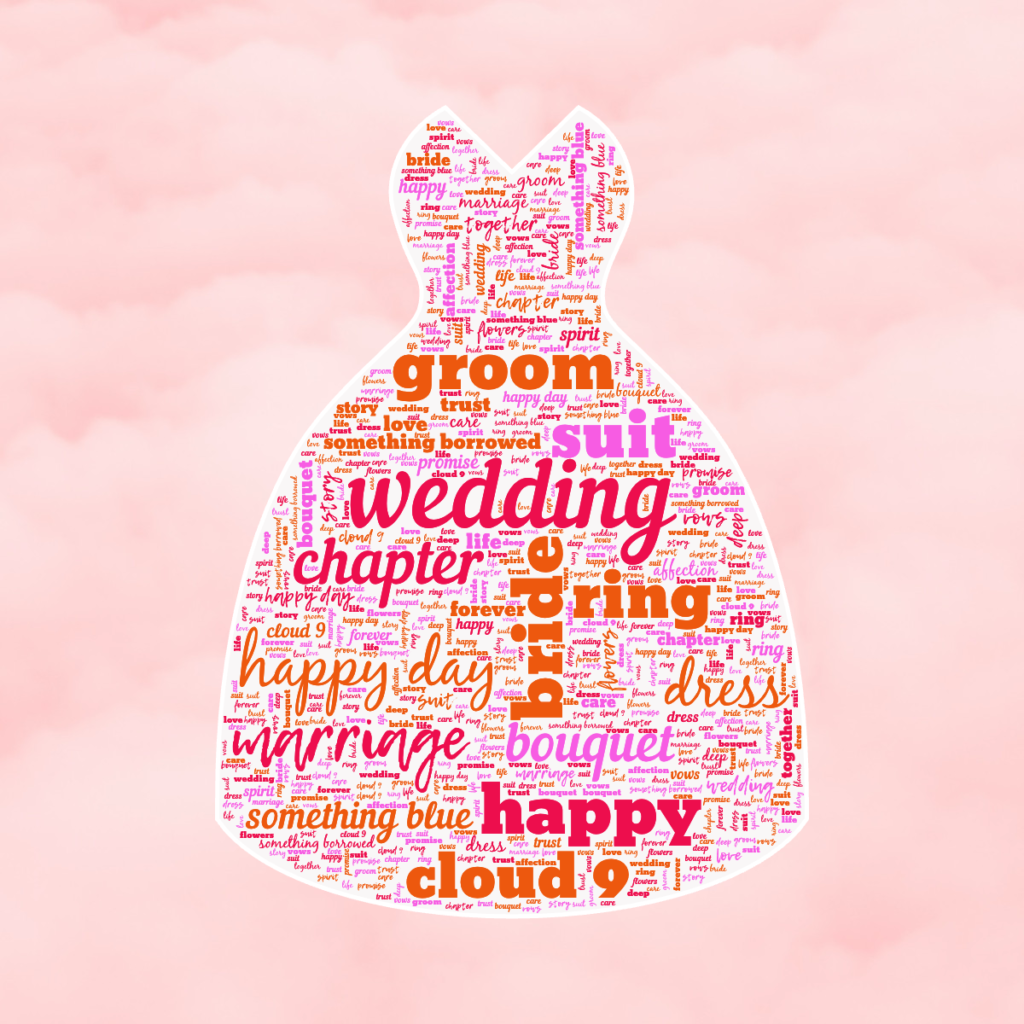
How Word Clouds Can Elevate Your Wedding Planning

Word Clouds for Party Planning
Journey Words
Words related to journey.
Below is a massive list of journey words - that is, words related to journey. The top 4 are: travel , trek , trip and excursion . You can get the definition(s) of a word in the list below by tapping the question-mark icon next to it. The words at the top of the list are the ones most associated with journey, and as you go down the relatedness becomes more slight. By default, the words are sorted by relevance/relatedness, but you can also get the most common journey terms by using the menu below, and there's also the option to sort the words alphabetically so you can get journey words starting with a particular letter. You can also filter the word list so it only shows words that are also related to another word of your choosing. So for example, you could enter "travel" and click "filter", and it'd give you words that are related to journey and travel.
You can highlight the terms by the frequency with which they occur in the written English language using the menu below. The frequency data is extracted from the English Wikipedia corpus, and updated regularly. If you just care about the words' direct semantic similarity to journey, then there's probably no need for this.
There are already a bunch of websites on the net that help you find synonyms for various words, but only a handful that help you find related , or even loosely associated words. So although you might see some synonyms of journey in the list below, many of the words below will have other relationships with journey - you could see a word with the exact opposite meaning in the word list, for example. So it's the sort of list that would be useful for helping you build a journey vocabulary list, or just a general journey word list for whatever purpose, but it's not necessarily going to be useful if you're looking for words that mean the same thing as journey (though it still might be handy for that).
If you're looking for names related to journey (e.g. business names, or pet names), this page might help you come up with ideas. The results below obviously aren't all going to be applicable for the actual name of your pet/blog/startup/etc., but hopefully they get your mind working and help you see the links between various concepts. If your pet/blog/etc. has something to do with journey, then it's obviously a good idea to use concepts or words to do with journey.
If you don't find what you're looking for in the list below, or if there's some sort of bug and it's not displaying journey related words, please send me feedback using this page. Thanks for using the site - I hope it is useful to you! 🐓

- destination
- exploration
- united states
- progression
- experiences
- approaching
- carriageway
- accommodation
- pleasure trip
- pilgrim's journey
- heavy metal music
- relationship
- manifestation
- rollercoaster
- introspection
- perspective
- realisation
- inspiration
- conversation
- understanding
- maintenance
- experimental
- experiments
- rock and roll hall of fame
That's about all the journey related words we've got! I hope this list of journey terms was useful to you in some way or another. The words down here at the bottom of the list will be in some way associated with journey, but perhaps tenuously (if you've currenly got it sorted by relevance, that is). If you have any feedback for the site, please share it here , but please note this is only a hobby project, so I may not be able to make regular updates to the site. Have a nice day! 🐢

Encouraging Words For Professionals On An Association Journey Including Stay Curious And Hungry
July 20, 2018 by Jeff Hurt
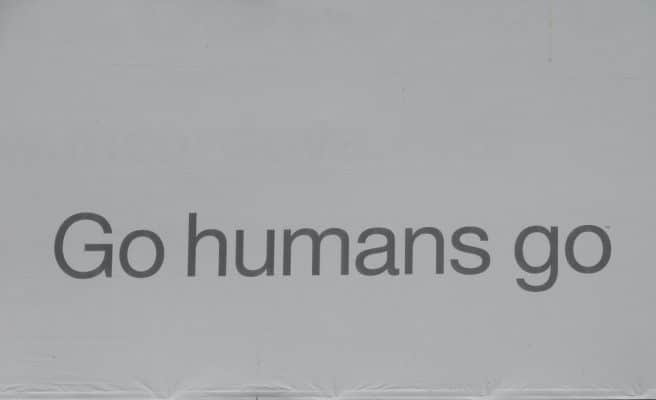
Encouragement by Kevin Spencer
Nothing we do is inevitable.
Our success as association professionals is not inevitable. Achieving a thriving conference and burgeoning membership is not inevitable.
We are not guaranteed that our association will stay small or that it will grow big. Nor are there any assurances that if we do everything right, at the right time, with the right people, we’ll succeed spectacularly—or nose dive miserably. So as long as you choose to take this amazing, exciting, frustrating, uncertain, fulfilling and terrifying journey of an association professional, here are a few words of encouragement to ponder and remember.
1. Stay Curious And Hungry
Why is it that some association professionals are in a rush for their organizations to become as average and dull as the ones they left? Sometimes it’s because we like the security of a steady paycheck and a regular routine.
If you have a team of volunteer leaders and staff working with you, they’ve probably already demonstrated that they are more adventurous, courageous and voracious than many. So why would you want to trade that curious, thirsty, life-long learning attitude for something as mundane as the status quo?
You need curiosity and that life-long thirst for learning. Your organization needs that same hunger and curious spirit. If you don’t model and supply it, who will?
2. You’re Not Alone.
If you are discouraged and feeling the darkness, remember you are not alone. It’s normal. And it won’t last forever. The sun will rise. The light will come. Darkness will be expelled.
Yes, there’s lot of joy, adventure and excitement on this association journey. There is also a lot of sadness, discouragement and even failure.
Failures and missteps are common. As long as you use them as learning experiences, you’ll recover. Don’t let them become a stopping place from forward movement.
If you’re in the zone of despair, pick up the phone and call a friend. Send a text and let a loved one know. They will hold you up and support you until the sun shines on your next steps in the adventure.
3. Stop Chasing Cool
Cool is boring. Cool is not fashionable. Chasing cool is not about how you dress, style your hair or use the next tech tool. Styles just come and go.
When you chase cool or hunt for the next cutting edge tech tool, you’re just following trends. You’re not a trendsetter at all.
Chasing cool doesn’t include people. It excludes them. It creates the in and out crowd. Cliques emerge.
People and associations that chase cool don’t change the world or anyone. You can’t change your world when you’re running frantically to keep up with it.
4. Avoid Copying Others
Sure, we all have leaders and organizations that we admire. We even learn from them.
However, we need to avoid copying them. Because when we do, we just become a faded, dull imitation.
If that’s all you ever do is sit around with like minded peers searching for tips and tricks to copy, you’re just chasing another association’s version of success. Don’t try to be them. Sometimes the best insights come from widening your scope beyond the common places you visit. It’s outside of your community that we‘ll see something we never expected.
5. Aim For Authenticity
Only you can do you! You are the best version of yourself. Be authentic.
There’s very little in our world today that is authentic and genuine. Most of the time it’s phony and pretentious. That’s why we are attracted to even the smallest glimpse of authenticity.
Don’t aim to be special. Or unique. Or cool. Aim for authenticity. Strive to be genuine.
No (hu)man who bothers about originality will ever be original: whereas if you simply try to tell the truth (without caring two pence how often it has been told before) you will, nine times out of ten, become original without ever having noticed it. ~ C. S. Lewis.
Take a breather occasionally. Rest regularly. Learn continually. Embrace every moment of this association journey. And be and do the best you possible.
Hat tips to authors C.S. Lewis, J.D. Greear and Karl Vaters.
What are some other words of encouragement you are willing to share with others along the association journey? Where do you turn when the weight of your nonprofit work takes its toll on your life?

Filed Under: Event Planning
I enjoyed this read. Being a part of an association has its highs and lows but you have to be hungry to stay in the game.
‘@Jill, thanks so much for reading and commenting. I agree with you that being a prat of an association has its ups and downs and staying hungry is the motivator to stay onboard. Keep fostering and stoking those hunger pangs for better, improvement and excellence.
A dear friend sent to me last week after a challenging time: F.A.I.L means First Attempt in Learning. It helped.
‘@Roberta. Nice! Thanks for reading and commenting too.
Leave a comment Cancel reply
Your email address will not be published. Required fields are marked *
My Association Journey to Association 4.0
Helping associations and nonprofits shape the future.

Build a Mission Worthy Team

Rule Your Market—Blue Ocean Strategy Sidesteps the Sharks

Build a Board for the Digital Future

Mix the Ones and Zeros With Xs and Os—Give IT Some Heart

Are Marketing and Membership at Opposite Poles? Take the Journey to Collaboration
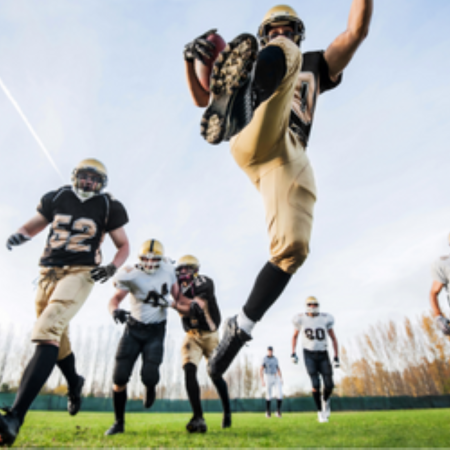
Association 4.0—A Playbook for Success

For Better Virtual Work Vibes—Try EI

Digital Empathy Brings Data to Life

Build a Successful Team, Know Where Your People Thrive

Lead From the Human Side of Technology
- Already have a WordPress.com account? Log in now.
- Subscribe Subscribed
- Report this content
- View site in Reader
- Manage subscriptions
- Collapse this bar

Travel Itinerary For One Week in Moscow: The Best of Moscow!
I just got back from one week in Moscow. And, as you might have already guessed, it was a mind-boggling experience. It was not my first trip to the Russian capital. But I hardly ever got enough time to explore this sprawling city. Visiting places for business rarely leaves enough time for sightseeing. I think that if you’ve got one week in Russia, you can also consider splitting your time between its largest cities (i.e. Saint Petersburg ) to get the most out of your trip. Seven days will let you see the majority of the main sights and go beyond just scratching the surface. In this post, I’m going to share with you my idea of the perfect travel itinerary for one week in Moscow.
Moscow is perhaps both the business and cultural hub of Russia. There is a lot more to see here than just the Kremlin and Saint Basil’s Cathedral. Centuries-old churches with onion-shaped domes dotted around the city are in stark contrast with newly completed impressive skyscrapers of Moscow City dominating the skyline. I spent a lot of time thinking about my Moscow itinerary before I left. And this city lived up to all of my expectations.

Travel Itinerary For One Week in Moscow
Day 1 – red square and the kremlin.
Metro Station: Okhotny Ryad on Red Line.
No trip to Moscow would be complete without seeing its main attraction. The Red Square is just a stone’s throw away from several metro stations. It is home to some of the most impressive architectural masterpieces in the city. The first thing you’ll probably notice after entering it and passing vendors selling weird fur hats is the fairytale-like looking Saint Basil’s Cathedral. It was built to commemorate one of the major victories of Ivan the Terrible. I once spent 20 minutes gazing at it, trying to find the perfect angle to snap it. It was easier said than done because of the hordes of locals and tourists.
As you continue strolling around Red Square, there’s no way you can miss Gum. It was widely known as the main department store during the Soviet Era. Now this large (yet historic) shopping mall is filled with expensive boutiques, pricey eateries, etc. During my trip to Moscow, I was on a tight budget. So I only took a retro-style stroll in Gum to get a rare glimpse of a place where Soviet leaders used to grocery shop and buy their stuff. In case you want some modern shopping experience, head to the Okhotny Ryad Shopping Center with stores like New Yorker, Zara, and Adidas.

Read More: Was Socotra a Mistake?
To continue this Moscow itinerary, next you may want to go inside the Kremlin walls. This is the center of Russian political power and the president’s official residence. If you’re planning to pay Kremlin a visit do your best to visit Ivan the Great Bell Tower as well. Go there as early as possible to avoid crowds and get an incredible bird’s-eye view. There are a couple of museums that are available during designated visiting hours. Make sure to book your ticket online and avoid lines.
Day 2 – Cathedral of Christ the Saviour, the Tretyakov Gallery, and the Arbat Street
Metro Station: Kropotkinskaya on Red Line
As soon as you start creating a Moscow itinerary for your second day, you’ll discover that there are plenty of metro stations that are much closer to certain sites. Depending on your route, take a closer look at the metro map to pick the closest.
The white marble walls of Christ the Saviour Cathedral are awe-inspiring. As you approach this tallest Orthodox Christian church, you may notice the bronze sculptures, magnificent arches, and cupolas that were created to commemorate Russia’s victory against Napoleon.

How to Get a Decent Haircut in a Foreign Country
Unfortunately, the current Cathedral is a replica, since original was blown to bits in 1931 by the Soviet government. The new cathedral basically follows the original design, but they have added some new elements such as marble high reliefs.
Home to some precious collection of artworks, in Tretyakov Gallery you can find more than 150,000 of works spanning centuries of artistic endeavor. Originally a privately owned gallery, it now has become one of the largest museums in Russia. The Gallery is often considered essential to visit. But I have encountered a lot of locals who have never been there.
Famous for its souvenirs, musicians, and theaters, Arbat street is among the few in Moscow that were turned into pedestrian zones. Arbat street is usually very busy with tourists and locals alike. My local friend once called it the oldest street in Moscow dating back to 1493. It is a kilometer long walking street filled with fancy gift shops, small cozy restaurants, lots of cute cafes, and street artists. It is closed to any vehicular traffic, so you can easily stroll it with kids.
Day 3 – Moscow River Boat Ride, Poklonnaya Hill Victory Park, the Moscow City
Metro Station: Kievskaya and Park Pobedy on Dark Blue Line / Vystavochnaya on Light Blue Line
Voyaging along the Moscow River is definitely one of the best ways to catch a glimpse of the city and see the attractions from a bit different perspective. Depending on your Moscow itinerary, travel budget and the time of the year, there are various types of boats available. In the summer there is no shortage of boats, and you’ll be spoiled for choice.

Travel Itinerary for One Week in Beijing
If you find yourself in Moscow during the winter months, I’d recommend going with Radisson boat cruise. These are often more expensive (yet comfy). They offer refreshments like tea, coffee, hot chocolate, and, of course, alcoholic drinks. Prices may vary but mostly depend on your food and drink selection. Find their main pier near the opulent Ukraine hotel . The hotel is one of the “Seven Sisters”, so if you’re into the charm of Stalinist architecture don’t miss a chance to stay there.
The area near Poklonnaya Hill has the closest relation to the country’s recent past. The memorial complex was completed in the mid-1990s to commemorate the Victory and WW2 casualties. Also known as the Great Patriotic War Museum, activities here include indoor attractions while the grounds around host an open-air museum with old tanks and other vehicles used on the battlefield.
How I Planned My Trip to Vietnam
The hallmark of the memorial complex and the first thing you see as you exit metro is the statue of Nike mounted to its column. This is a very impressive Obelisk with a statue of Saint George slaying the dragon at its base.
Maybe not as impressive as Shanghai’s Oriental Pearl Tower , the skyscrapers of the Moscow City (otherwise known as Moscow International Business Center) are so drastically different from dull Soviet architecture. With 239 meters and 60 floors, the Empire Tower is the seventh highest building in the business district.
The observation deck occupies 56 floor from where you have some panoramic views of the city. I loved the view in the direction of Moscow State University and Luzhniki stadium as well to the other side with residential quarters. The entrance fee is pricey, but if you’re want to get a bird’s eye view, the skyscraper is one of the best places for doing just that.
Day 4 – VDNKh, Worker and Collective Farm Woman Monument, The Ostankino TV Tower
Metro Station: VDNKh on Orange Line
VDNKh is one of my favorite attractions in Moscow. The weird abbreviation actually stands for Russian vystavka dostizheniy narodnogo khozyaystva (Exhibition of Achievements of the National Economy). With more than 200 buildings and 30 pavilions on the grounds, VDNKh serves as an open-air museum. You can easily spend a full day here since the park occupies a very large area.

Places to Visit in Barcelona That Aren’t Beaches
First, there are pavilions that used to showcase different cultures the USSR was made of. Additionally, there is a number of shopping pavilions, as well as Moskvarium (an Oceanarium) that features a variety of marine species. VDNKh is a popular venue for events and fairs. There is always something going on, so I’d recommend checking their website if you want to see some particular exhibition.
A stone’s throw away from VDNKh there is a very distinctive 25-meters high monument. Originally built in 1937 for the world fair in Paris, the hulking figures of men and women holding a hammer and a sickle represent the Soviet idea of united workers and farmers. It doesn’t take much time to see the monument, but visiting it gives some idea of the Soviet Union’s grandiose aspirations.
I have a thing for tall buildings. So to continue my travel itinerary for one week in Moscow I decided to climb the fourth highest TV tower in the world. This iconic 540m tower is a fixture of the skyline. You can see it virtually from everywhere in Moscow, and this is where you can get the best panoramic views (yep, even better than Empire skyscraper).

Parts of the floor are made of tempered glass, so it can be quite scary to exit the elevator. But trust me, as you start observing buildings and cars below, you won’t want to leave. There is only a limited number of tickets per day, so you may want to book online. Insider tip: the first tour is cheaper, you can save up to $10 if go there early.
Day 5 – A Tour To Moscow Manor Houses
Metro Station: Kolomenskoye, Tsaritsyno on Dark Green Line / Kuskovo on Purple Line
I love visiting the manor houses and palaces in Moscow. These opulent buildings were generally built to house Russian aristocratic families and monarchs. Houses tend to be rather grand affairs with impressive architecture. And, depending on the whims of the owners, some form of a landscaped garden.
During the early part of the 20th century though, many of Russia’s aristocratic families (including the family of the last emperor) ended up being killed or moving abroad . Their manor houses were nationalized. Some time later (after the fall of the USSR) these were open to the public. It means that today a great many of Moscow’s finest manor houses and palaces are open for touring.

20 Travel Tips I’ve Learned From Travelling The World
There are 20 manor houses scattered throughout the city and more than 25 in the area around. But not all of them easily accessible and exploring them often takes a lot of time. I’d recommend focusing on three most popular estates in Moscow that are some 30-minute metro ride away from Kremlin.
Sandwiched between the Moscow River and the Andropov Avenue, Kolomenskoye is a UNESCO site that became a public park in the 1920’s. Once a former royal estate, now it is one of the most tranquil parks in the city with gorgeous views. The Ascension Church, The White Column, and the grounds are a truly grand place to visit.
You could easily spend a full day here, exploring a traditional Russian village (that is, in fact, a market), picnicking by the river, enjoying the Eastern Orthodox church architecture, hiking the grounds as well as and wandering the park and gardens with wildflower meadows, apple orchards, and birch and maple groves. The estate museum showcases Russian nature at its finest year-round.
12 Stunning National Parks and Regional Parks In France
If my travel itinerary for one week in Moscow was a family tree, Tsaritsyno Park would probably be the crazy uncle that no-one talks about. It’s a large park in the south of the city of mind-boggling proportions, unbelievable in so many ways, and yet most travelers have never heard of it.
The palace was supposed to be a summer home for Empress Catherine the Great. But since the construction didn’t meet with her approval the palace was abandoned. Since the early 1990’s the palace, the pond, and the grounds have been undergoing renovations. The entire complex is now looking brighter and more elaborately decorated than at possibly any other time during its history. Like most parks in Moscow, you can visit Tsaritsyno free of charge, but there is a small fee if you want to visit the palace.

How To Stop Procrastinating When Trip Planning
Last, but by no means least on my Moscow itinerary is Kuskovo Park . This is definitely an off-the-beaten-path place. While it is not easily accessible, you will be rewarded with a lack of crowds. This 18th-century summer country house of the Sheremetev family was one of the first summer country estates of the Russian nobility. And when you visit you’ll quickly realize why locals love this park.
Like many other estates, Kuskovo has just been renovated. So there are lovely French formal garden, a grotto, and the Dutch house to explore. Make sure to plan your itinerary well because the estate is some way from a metro station.

Day 6 – Explore the Golden Ring
Creating the Moscow itinerary may keep you busy for days with the seemingly endless amount of things to do. Visiting the so-called Golden Ring is like stepping back in time. Golden Ring is a “theme route” devised by promotion-minded journalist and writer Yuri Bychkov.
Having started in Moscow the route will take you through a number of historical cities. It now includes Suzdal, Vladimir, Kostroma, Yaroslavl and Sergiev Posad. All these awe-inspiring towns have their own smaller kremlins and feature dramatic churches with onion-shaped domes, tranquil residential areas, and other architectural landmarks.
Two Weeks In Thailand: The Perfect 14-Day Itinerary
I only visited two out of eight cities included on the route. It is a no-brainer that Sergiev Posad is the nearest and the easiest city to see on a day trip from Moscow. That being said, you can explore its main attractions in just one day. Located some 70 km north-east of the Russian capital, this tiny and overlooked town is home to Trinity Lavra of St. Sergius, UNESCO Site.

You Will Also Like: 3-Day London Itinerary
Sergiev Posad is often described as being at the heart of Russian spiritual life. So it is uncommon to see the crowds of Russian pilgrims showing a deep reverence for their religion. If you’re traveling independently and using public transport, you can reach Sergiev Posad by bus (departs from VDNKh) or by suburban commuter train from Yaroslavskaya Railway Station (Bahnhof). It takes about one and a half hours to reach the town.
Trinity Lavra of St. Sergius is a great place to get a glimpse of filling and warming Russian lunch, specifically at the “ Gostevaya Izba ” restaurant. Try the duck breast, hearty potato and vegetables, and the awesome Napoleon cake.
Day 7 – Gorky Park, Izmailovo Kremlin, Patriarch’s Ponds
Metro Station: Park Kultury or Oktyabrskaya on Circle Line / Partizanskaya on Dark Blue Line / Pushkinskaya on Dark Green Line
Gorky Park is in the heart of Moscow. It offers many different types of outdoor activities, such as dancing, cycling, skateboarding, walking, jogging, and anything else you can do in a park. Named after Maxim Gorky, this sprawling and lovely park is where locals go on a picnic, relax and enjoy free yoga classes. It’s a popular place to bike around, and there is a Muzeon Art Park not far from here. A dynamic location with a younger vibe. There is also a pier, so you can take a cruise along the river too.

How to Save Money While Traveling in Europe
The Kremlin in Izmailovo is by no means like the one you can find near the Red Square. Originally built for decorative purposes, it now features the Vernissage flea market and a number of frequent fairs, exhibitions, and conferences. Every weekend, there’s a giant flea market in Izmailovo, where dozens of stalls sell Soviet propaganda crap, Russian nesting dolls, vinyl records, jewelry and just about any object you can imagine. Go early in the morning if you want to beat the crowds.
All the Bulgakov’s fans should pay a visit to Patriarch’s Ponds (yup, that is plural). With a lovely small city park and the only one (!) pond in the middle, the location is where the opening scene of Bulgakov’s novel Master and Margarita was set. The novel is centered around a visit by Devil to the atheistic Soviet Union is considered by many critics to be one of the best novels of the 20th century. I spent great two hours strolling the nearby streets and having lunch in the hipster cafe.
Conclusion and Recommendations
To conclude, Moscow is a safe city to visit. I have never had a problem with getting around and most locals are really friendly once they know you’re a foreigner. Moscow has undergone some serious reconstruction over the last few years. So you can expect some places to be completely different. I hope my one week Moscow itinerary was helpful! If you have less time, say 4 days or 5 days, I would cut out day 6 and day 7. You could save the Golden Ring for a separate trip entirely as there’s lots to see!
What are your thoughts on this one week Moscow itinerary? Are you excited about your first time in the city? Let me know in the comments below!
JOIN MY FREE WEEKLY NEWSLETTER!
Email Address *
YOU WILL ALSO LIKE

10 Dishes You Must Try When Going To Moscow

15 Fantastic and Easy Day Trips Close to Moscow

When Is the Best Time To Visit Russia
24 comments.
Ann Snook-Moreau
Moscow looks so beautiful and historic! Thanks for including public transit information for those of us who don’t like to rent cars.
MindTheTravel
Yup, that is me 🙂 Rarely rent + stick to the metro = Full wallet!
Mariella Blago
Looks like you had loads of fun! Well done. Also great value post for travel lovers.
Thanks, Mariella!
I have always wanted to go to Russia, especially Moscow. These sights look absolutely beautiful to see and there is so much history there!
Agree! Moscow is a thousand-year-old city and there is definitely something for everyone.
Tara Pittman
Those are amazing buildings. Looks like a place that would be amazing to visit.
Adriana Lopez
Never been to Moscow or Russia but my family has. Many great spots and a lot of culture. Your itinerary sounds fantastic and covers a lot despite it is only a short period of time.
What was their favourite thing about Russia?
Gladys Parker
I know very little about Moscow or Russia for the\at matter. I do know I would have to see the Red Square and all of its exquisite architectural masterpieces. Also the CATHEDRAL OF CHRIST THE SAVIOUR. Thanks for shedding some light on visiting Moscow.
Thanks for swinging by! The Red Square is a great starting point, but there way too many places and things to discover aside from it!
Ruthy @ Percolate Kitchen
You are making me so jealous!! I’ve always wanted to see Russia.
Moscow is in my bucket list, I don’t know when I can visit there, your post is really useful. As a culture rich place we need to spend at least week.
DANA GUTKOWSKI
Looks like you had a great trip! Thanks for all the great info! I’ve never been in to Russia, but this post makes me wanna go now!
Wow this is amazing! Moscow is on my bucket list – such an amazing place to visit I can imagine! I can’t wait to go there one day!
The building on the second picture looks familiar. I keep seeing that on TV.
Reesa Lewandowski
What beautiful moments! I always wish I had the personality to travel more like this!
Perfect itinerary for spending a week in Moscow! So many places to visit and it looks like you had a wonderful time. I would love to climb that tower. The views I am sure must have been amazing!
I was lucky enough to see the skyline of Moscow from this TV Tower and it is definitely mind-blowing.
Chelsea Pearl
Moscow is definitely up there on my travel bucket list. So much history and iconic architecture!
Thumbs up! 🙂
Blair Villanueva
OMG I dream to visit Moscow someday! Hope the visa processing would be okay (and become more affordable) so I could pursue my dream trip!
Yup, visa processing is the major downside! Agree! Time and the money consuming process…
Save my name, email, and website in this browser for the next time I comment.

- Privacy Overview
- Strictly Necessary Cookies
My website uses cookies so that I can provide you with the best user experience possible. Cookie information is stored in your browser and performs functions such as recognising you when you return to my website and helping me to understand which sections of Mind The Travel you find most interesting and useful.
You can adjust all of your cookie settings by navigating the tabs on the left hand side.
Strictly Necessary Cookie should be enabled at all times so that I can save your preferences for cookie settings.
If you disable this cookie, I will not be able to save your preferences. This means that every time you visit my website you will need to enable or disable cookies again.

- WEB STORIES New
- ENTERTAINMENT
- CAREER & CAMPUS
- INFOGRAPHICS
- ISL 2023-24

- Manorama Online
- Manorama News TV
- ManoramaMAX
- Radio Mango
- Subscription

Arriving in Moscow soon? Here's a guide on riding to and from city airports
Your Moscow tour is about to begin and you just landed in the city. How will you go to the city centre without relying on anyone or getting ripped off by taxi drivers? Or, probably, you are in a hurry to take a connection flight from another airport or head to the railway station to catch the train on the Trans-Siberian route. Students are likely to take the next train to the university in another city in Russia.
Know all the options to travel to and from the airport beforehand if you have not engaged a tour company for the hotel transfer or city tour.
Premier airport shuttle train, named Aeroexpress, is the fastest and most convenient option. There are express bus service as well apart from taxis. No doubt, these three options are comfortable.
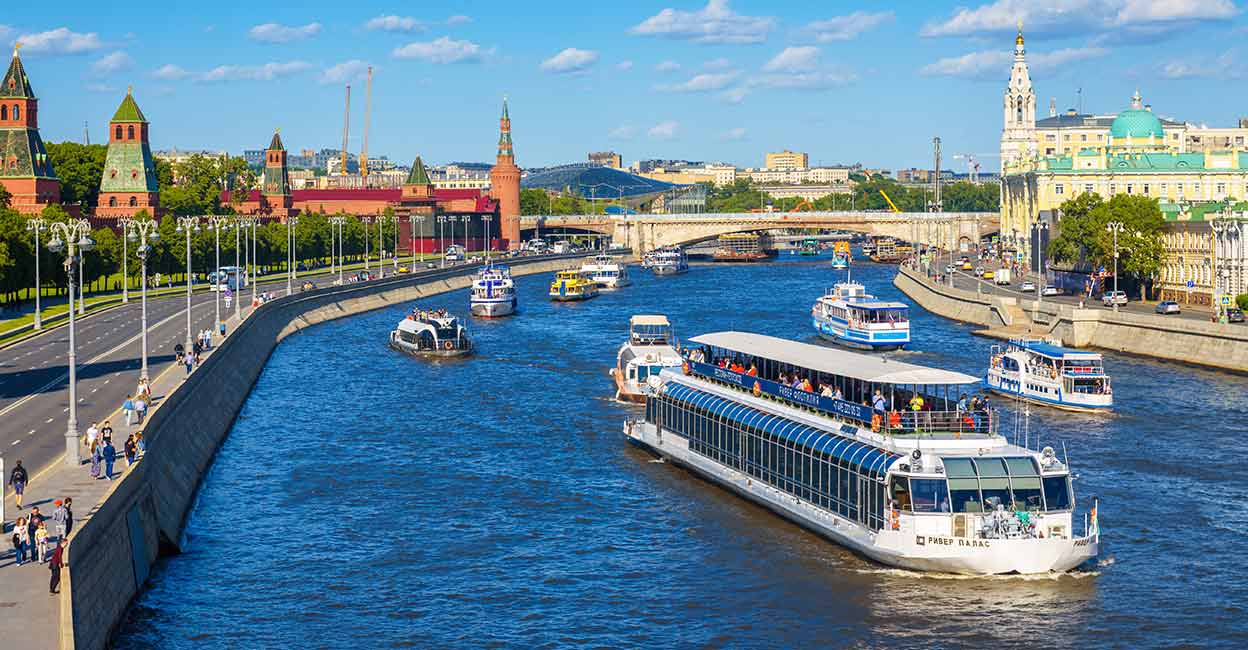
Moscow makes a bid to woo tourists; Foreign Tourist Card in the offing
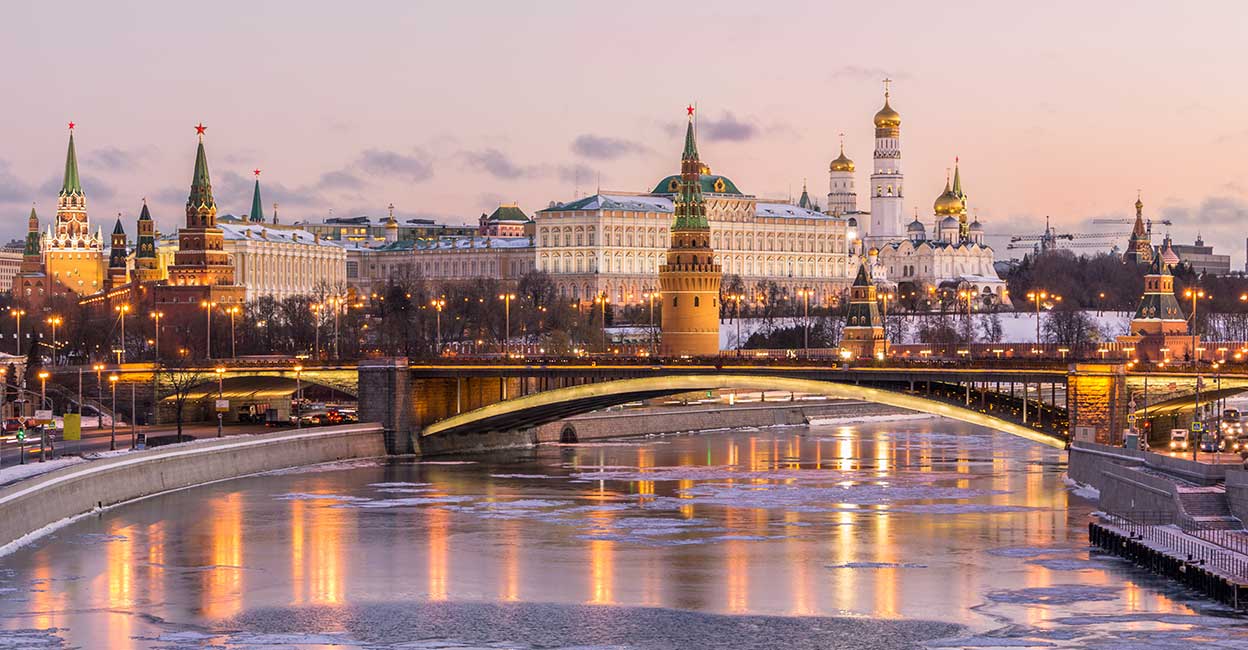
How to explore Moscow Kremlin? Here's a detailed guide
If you are not in a hurry and with only a backpack, hop onto a city bus; but most buses won't go to the heart of the city. The bus ride is the cheapest, but not comfortable for a tourist.
Choose one mode of transport that suits you well in terms of convenience, money, time and safety.
Knowing about the city airports and their location will help you take the right call. Also some knowledge of the main railway stations and the metro railway too will help as you explore the city or criss-cross it for travelling out.
A) Airports
Befitting its status as a megacity and a major transportation hub, Moscow has four international airports — Sheremetyevo, Domodedovo, Vnukovo and the newest, Zhukovsky — located in different locations away from the downtown but often closer to the nearest flight paths of regions/destinations served by the airports.
Any domestic or international tourist is likely to arrive at one of these four commercial airports and most likely in either of the first two — Sheremetyevo or Domodedovo — which are located at the opposite ends of the city.
A fifth one — Ostafyevo International Business Airport — is not for civil aviation, but, as the name suggests, for business aviation. (The airport is for private aircraft, charter services, aircraft maintenance, refuelling and parking and the like apart from the dedicated use by Russian energy giant Gazprom.)
All these airports lie around the city in all the directions and travel between the two nearest ones requires an hour or more by road.

There are a few more airports in and around the city but they are either for military or cargo aircraft.
1. Sheremetyevo International Airport
Sheremetyevo (SVO) is the busiest airport in Russia itself and the second-busiest in Europe. It is to the northwest of Moscow, about 35 km from the centre of the city, viz. the Red Square.
SVO is the best option for domestic flights too. Being the base of the Russian national carrier Aeroflot, flights to all corners of the vast country are easily available.

The formal name is Sheremetyevo Alexander S Pushkin International Airport.
2. Domodedovo International Airport
Domodedovo (DME), the second busiest airport in Russia, is just behind Sheremetyevo in terms of passenger traffic. It is about 45 km southeast of Moscow.
The formal name is Domodedovo Mikhail Lomonosov International Airport.

Travellers intending to take connection flight from SVO or DME after arriving at either of the two should book a flight with a gap of at least 4 hours. A taxi ride between these two airports — 70 km apart — will take about 2 hours and 15 minutes: more with a major traffic block on the way; however, from Domodedovo to Vnukovo Airport the taxi can take you in 1 hour 30 minutes.
From Domodedovo the taxi ride to major railway stations will be between 1 hour 30 minutes and 2 hours.

At the Domodedovo airport a treat awaits cargeeks: a collection of vintage cars is on display. NOTE:
1. A transit visa is required for international travellers boarding flight from a different airport or even to visit the city after first arriving at another one. Please try to get the connection flight that departs from the arrival airport in less than 24 hours to avoid the hassle of obtaining a transit visa.

2. Transit visa is valid for 72 hours if travelling by air. The validity is 10 days if you intend a road journey to another country.
3. To apply for a transit visa at the Russian Embassy/Consulate you only need 1) a copy of the visa of the destination country, if at all that is required, 2) DEFINITELY the copy of fight tickets for arriving and departing from airports in Russia. On your return if you intend to transit again, please don't forget to mention Double Entry as you apply for the transit visa, 3) and a cover letter stating the purpose and itinerary.
3. Vnukovo International Airport
Vnukovo Andrei Tupolev International Airport (VKO) is closer to the city than the other airports. It is just 28 km southwest of the city centre. It is the oldest airport in operation in Moscow. It is smaller than SVO and DME and trails them in terms of traffic. The airport primarily serves flights to and from the North Caucasus and destinations near the Black Sea. Destinations south of Moscow too has connectivity from here. The domestic and overseas destinations include Grozny, Tashkent, Astana, Bukhara, St Petersburg, Baku, Sochi, Yeravan, Dushanbe, Samara, Dubai and Istanbul. Flights to even a few Far East destinations in Russia are also available. Flights to Ukraine stand cancelled with the outbreak of hostilities in early 2021.
4. Zhukovsky International Airport
Zhukovksy (ZIA) airport commenced commercial services in 2016. It is 43 km southeast of the city centre and close to the defunct Bykovo Airport. Domodedovo airport too is nearly of the same distance from Zhukovksy but to its southwest. Destinations served from Zhukovksy include Antalya, İstanbul, Almaty, Dushanbe, Bishkek, Sabetta (on the Yamal Peninsula).
B) Major Railway Stations
Moscow has rail connectivity to all parts of Russia. International trains link Moscow to cities in Europe and Asia (in China and Mongolia.)
(Trains to Europe stand cancelled with the imposition of sanctions by the West following Russia's invasion of Ukraine in early 2022.)
Trains depart from 10 railway terminals in Moscow. These are: Belorussky, Kazansky, Kievsky, Kursky, Leningradsky, Paveletsky, Rizhsky, Savyolovsky, Yaroslavsky and Vostochny, the latter being the newest that opened in May 2021.
The stations of the Moscow Metro, though mostly underground, are close to these railway terminals. You have to follow the signs to flit between the railway stations and the nearest metro station; at some places you may have to just cross the road - but don't worry a metro station is always near!

For tourists there is scope for confusion regarding the name of the railway station and the nearest metro station. For instance the metro station closest to Paveletsky railway station is called Paveletskaya.
Metro stations can be identified with the distinct sign 'M'.
Do you know the Moscow Metro themselves are tourist attractions?
Suburban trains and monrail too are there, but none as important as the legendary and century-old Moscow Metro — "one of the most beautiful underground systems in the world."
You may download the interactive Yandex Moscow Metro app to identify stations and lines as well as to plan your trip.
During your Moscow tour you are unlikely to miss the Russian Railways' logo stylised in Cyrillic as PZD - the Russian acronym of Rossiyskie Sheleznye Dorogi.
1. No long-distance trains run from Savyolovsky.
2. No suburban trains are operated from Vostochny.
3. 'Vostochny' means 'Eastern'. Vostochny terminal came up at the site of the Cherkizovo railway station. It is the first to be built in ther last 100 years; Kievsky, the last one, was inaugurated in 1918.
4. Leningradsky, which is in operation since 1851, is the oldest railway station in Moscow.
C) Aeroexpress Trains
New-generation double- and single-decker high-speed trains, named Aeroexpress, provide the most comfortable and the fastest connectivity between the main airports in Moscow and the major railway stations in the city.
The rail link to Moscow city by way of Aeroexpress is available at Sheremetyevo, Domodedovo and Vnukovo airports.

The trains also stop at a few stations in between their terminals at airports and the downtown railway stations.
Main routes and travel time
1. Sheremetyevo Airport-Belorussky Railway Station. (65 minutes from/till SVO Terminals B and C.)
2. Sheremetyevo Airport-Savyolovsky Rail Terminal (of suburban trains). (60 min from/till SVO Terminals B and C.
3. Domodedovo Airport-Paveletsky Railway Station. 45 minutes
4. Vnukovo Airport-Kievsky Rail Terminal. 35 minutes
Where else to board/alight?
• At Sheremetyevo Airport the Aeroexpress train starts from Terminals B and C. It can be boarded from Terminals D, E, F too where the train arrives 10 min after departing.
• In the city, the Sheremetyevo Aeroexpress train can be boarded from a special platform near the Okruzhnaya station on the Moscow Central Circle (MCC) metro line. To reach the platform you need to cross the road after exiting the MCC Okruzhnaya. Don't worry: just follow the directions. (Okruzhnaya is 10 km north of Belorussky Railway Station.)

• The Domodedovo Aeroexpress train stops at Domodedovo town railway station on Platform 3.
• In downtown Moscow, you may also board or alight from the Domodedovo Aeroexpress train at a separate platform built at a short distance from the MCC Verkhny Kotly metro station. This is near the Paveletsky Rail Terminal where the Aeroexpress to Domodedovo begins or ends journey. Nagatinskaya metro station is also near Verkhny Kotly.
• Non-Aeroexpress trains taking the line between Domodedovo town and Paveletsky too stop at the beforementioned Verkhny Kotly Aeroexpress platform.
Tickets and fare
Aeroexpress has two classes of coaches: Standard and Business.
Tickets can be bought at the Aeroexpress terminal at airports and railway stations. You may even buy them online in advance: 90 days ahead.
At airports you may even come across sales personnel in distinct uniform as you proceed to the Aeroexpress terminal. They may even guide you.
Ticket vending machine is another option as long as you can make out the instructions or know to operate it. Also, using your card you may buy a digital ticket at the turnstiles using the Pay@Gate service.
The lowest fare for one ride is 450 Roubles (for Standard class); for round-trip it is 450 RUB. The fare for Business class is 1,000 and 1,900 RUB for single and round trips, respectively. A family pack too is available - roundtrip ticket for two adults and two children costs 1,400 RUB; it's free for children below 5 years. (NB: The prices as of Nov, 2022.)
Aeroexpress trains run from morning (by six o'clock) to midnight every 30 minutes. The travel time is 45 to 60 minutes.

On the train there is ample space to place your luggage. Bulky ones, if any, you may keep it on the shelf close to the door. In other words you don't have to drag them to place them near or above your seat. Save your energy for the city tour! Your luggage is safe: cameras are keeping an eye everywhere in Moscow. Never mind casting an occasional glance on the goods.
Light refreshments are served on the Aeroexpress trains. Buy.
For Aeroexpress seat bookings and to know about the exact fare, timings and intermediate stoppages please check the official website .
1. It is easy to spot the directions to Aeroexpress terminal at airports. Just follow the signs spotted at the arrival terminals. At railway stations and at metro stations the directions for the Aeroexpress terminal may not be that conspicuous.
2. You have to press the RED button on the door to open it for alighting from the train. Tourists are likely to wait for the door to open automatically; at intermediate stations the delay may prove costly as the train will depart with you still on board!

D) Aeroexpress Express Bus
Aeroexpress express buses too are in operation from Sheremetyevo and Domodedovo airports. Look for the Aeroexpress logo on red buses. Tickets can be bought from the driver if you could not purchase at the counter or online or through the vending machines or as mentioned above.
The buses to Sheremetyevo Airport Terminals B and C are available from Khovrino metro station at exit no: 2. They are available every 15-30 minutes from morning to midnight (05:50 to 00:05). Route No: 1195.
At the airport you can board the bus near the exit from the Terminals B and C.
The travel time is about 20 minutes. The fare is 250 RUB.
The Aeroexpress express bus to Domodedovo Airport runs from the Domodedovskaya metro station. The travel time is about 40 minutes and the fare is 80 RUB. The frequency is 20 minutes. Route No: 1185.
At the Domodedovskaya metro station the bus is parked near exit No.10. At the airport it is stationed on the forecourt opposite Exit No.3.
The bus service on this route too is available from early morning to midnight.
E) City Bus and Marshrutka Shuttle
Regular non-express city buses and vans (marshrutka) that ply to nearest metro stations are also available outside the airports. After getting down from the bus/van, take the metro train to head to your destination in the downtown or any other part of the city.
As buses and vans are the cheapest option backpackers and those on a shoe-string budget may try them for reaching the hostel or other accommodation. Often non-tourists who have visited the city earlier take the bus to reach educational and industrial centres or even to visit friends, relatives, business contacts etc.
The bus and van fares are less than 100 RUB. Expect extra luggage fee.

Journey time on buses and shuttle vans running to and fro airports ranges from 30 min to 1 hour. Before your arrival, refer to the airport website for exact timings, cancellations, new routes and fares.
Bus journeys offer an immersive experience and familiarise you with the intracies of city life.
From Sheremetyevo Airport
Route Nos: 817 and 948 go to Planernaya metro station which is on the metro line No. 7 or Tagansko–Krasnopresnenskaya line — the busiest. The journey time is about 40 minutes. (817 is a bus and 948 a van.)
Route Nos: 851 and 949 go to Rechnoy Vokzal metro Station which is on metro line No.2 or the Zamoskvoretskaya line. (851 is a bus and 949 a van.)
Route No. Н1 has a night bus going to Kitay-gorod metro station which is on metro line Nos 6 and 7. Journey time: upto 1 hour.
This late-night service is very helpful for those landing at night at Sheremetyevo and have a hotel booking in the heart of the city, close to the Kremlin and Red Square. The frequency is every 30 minutes from 23:45 to 04:45. It is about midnight the Aeroexpress runs its last train of the day before resuming trips around the daybreak.
There are also buses to the towns of Khimki and Lobnya from morning to night from the Sheremetyevo Airport.
(Planernaya and Rechnoy Vokzal are to the north of the city and Kitay-gorod is at the centre.)
From Domodedovo Airport
Buses and shuttle buses depart from the forecourt (Exit No. 3).
Route No.308 goes to Domodedovskaya metro station which is on the metro line No.2 or Zamoskvoretskaya metro. Journey time: about 45 minutes.
Route No.30 is to Domodedovo town. Journey time: about 55 minutes.
Route No.11 is to Novoye (New) Domodedovo. Journey time: about 35 minutes.
Route No. 26 is to Krasny Put. Journey time: about 45 minutes.
Route No. 999 is to Ryazan, via Kolomna and Lukhovitsy. This is comparatively a long-distance route further southeast of Domodedovo. Journey time to Ryazan is 3 to 3 1/2 hours; Lukhovitsy is a little more than 2 hours and Kolomna is a little more than 1/2 hours. For these destinations the fares are from 400 to 600 RUB.
Shuttle bus No. 52 goes to Vzletnaya. Journey time: 20-25 minutes.
Shuttle bus No. 17К goes to Rastunovo (Zarya). Journey time: 40 minutes.
(Krasny Put is near the centre of the city, about 6 km from Red Square. Novoye Domodedovo, a modern residential estate, is just 15 km west of the airport. Vzletnaya is famous for a hotel about 10 km from the Domodedovo Airport.)
From Vnukovo Airport
Buses displaying Route Nos.611, 611c and 611ф (ф = f) go to Yugo-Zapadnaya metro station which is on line no. 1. Travel time is 40 minutes or less.
Mini-bus (Route No. 45M) is also availble from morning to night between the airport and Yugo-Zapadnaya metro station. Find it in front of the terminal A.

From Zhukovsky Airport
At Zhukovsky Airport you don't get direct transport to the heart of Moscow. Of course, taxis do go and they will drop you in about 1 hour. Opt for taxis for your Zhukovsky Airport trips either way.
The other alternative, the cheapest, is a combo of bus and metro ride or bus, train and metro rides.
Here are the options:
• The bus on Route 441 goes to Kotelniki metro station which is on metro line No. 7. Journey time is 1 hour. The metro will take you to the Moscow city centre.
• Take the shuttle bus to Otdyh suburban railway station. Journey time: 20 minutes. At Otdyh take the Sputnik express train to Kazansky Station in the centre of Moscow. Journey time: 40 minutes. Now, go to the nearby metro station, Komsomolskaya, if you want to reach the downtown or other parts of the Moscow city.
Mini bus No. 2 or No. 6 also run between the Zhukovsky Airport and the Otdyh station.
(Kotelniki and Otdyh are to the southeast of the city as is Zhukovsky Airport. )
You will never be stuck in any Moscow airport at whatever time you may arrive. Taxis are available round the clock as in any other major airport the world over. Cab drivers may accost you as soon as you exit from the terminal, but book with an authorized taxi operator at the dedicated desk. First, ensure your safety in a distant land.
As is the global practice, the taxi fare depends on the distance, time of day, and demand. To avoid the risk of over-charging book the taxi online or at the airport taxi desk, but do so only after claiming your baggage.
Taxi stands are near the Arrival halls.

The approximate fare from Sheremetyevo Airport to the city centre is 1,250 RUB, states the SVO website. The downtown ride from Domodedovo Airport will cost about 2,500 RUB, but it is about 1,500 RUB or little more if you are dropped much before (as on Nov 2022).
The fare for premier or luxury car, as to be expected, is higher. You will be charged extra for oversized baggage on taxis.
The authorised taxi operator at Sheremetyevo Airport is Yandex. At Moscow Domodedovo Airport the cab service is run by Domtrans.
Car rental too is available. Min-bus too can be hired if you are part of a large group.
NOTE: Most drivers speak only Russian. Lucky if you find one conversant in English. Use the Yandex Translate app — download it even before you take the flight to Moscow.
We wish you a nice trip.
(The airport websites have been referred to for preparing this tourist guide.)
- Beyond Kerala

Ooty – Coonoor toy trains beckon tourists: Here's how to book tickets

Planning to travel abroad? This is how much cash you can carry

Why is Azerbaijan one of the most favoured destinations of Indian travellers?

Yemen: Why does a cloud of fear hang over this country?

Travelling to these tourist spots can be expensive this year: Here's why

Dream of the Desert: Saudi Arabia to roll out Middle East’s first luxury train
"journey" statistics
statistical information is copyright © 2003-2024 wordassociation.org
2018 Primetime Emmy & James Beard Award Winner
R&K Insider
Join our newsletter to get exclusives on where our correspondents travel, what they eat, where they stay. Free to sign up.
A History of Moscow in 13 Dishes
Featured city guides.

17 Exciting Things to do in Moscow
Written By: Linda Voltaire
Updated On: December 21, 2022
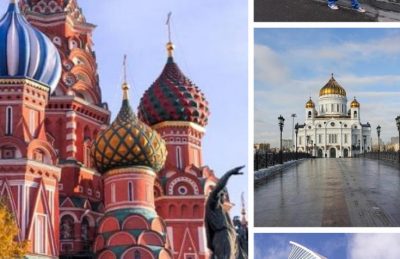
Visiting Russia? These are the top 17 things to do in Moscow to help you plan your trip.
If the western world has New York City , the first great metropolis on the eastern side of our planet is Moscow. A huge city with a complicated and impressive history, Moscow gets a bad rep over Russian politics – but that doesn’t make it any less impressive. Capital to the largest country in the world, Moscow takes the grandeur of its standing very seriously.
This is a place where luxury is king and where opulence takes a front seat in every aspect of life. The buildings are grand and imposing, the parks are luscious and enormous, and even the subway stations look different in Moscow than anywhere else in the world.
Table of Contents
Best Things to do in Moscow, Russia
Walking around Moscow is also going through the tumultuous history of the 20th century, which had Russia as one of its main protagonists. There are fascinating remains of these times everywhere in the former Soviet capital, from the gorgeous Seven Sisters skyscrapers to the Orthodox cathedrals that were closed for the better part of a century. Still, Moscow is also a completely modern city, with a vibrant social and party scene, incredible restaurants, and some of the most luxurious hotels in the world.
After living in Russia’s capital as an ex-pat for four years, I got the privilege to experience not only the main attractions in Moscow but also the everyday life in this huge city and quickly found my sweat spots off the beaten tracks! So here is my list of my top 17 things to do in this exciting metropolis!
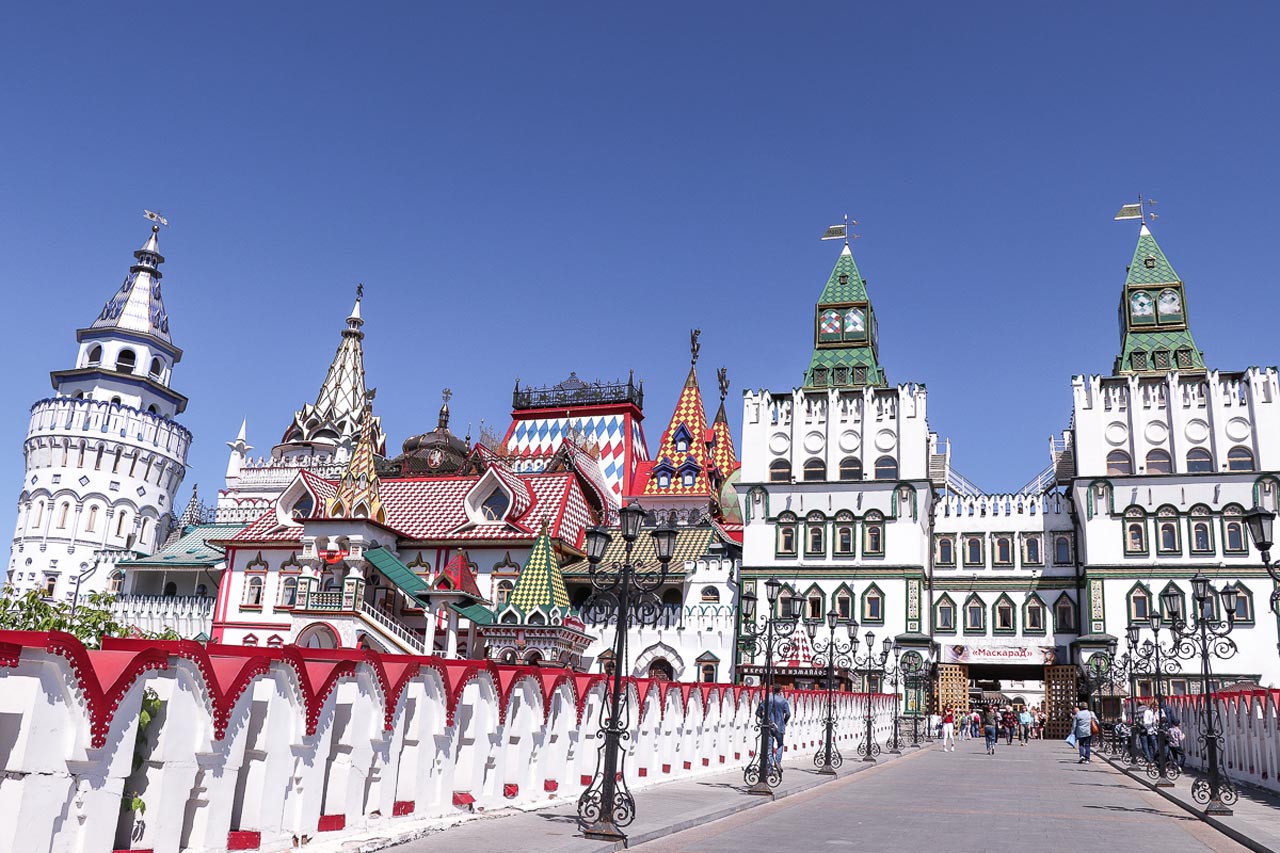
Attractions in Moscow
When visiting a famous city like this one, it’s a must to go through the most iconic landmarks first. Moscow has plenty of those, most of them in the center of the city, which is very well-planned for tourists.
1. The Red Square, Kremlin & Surrounding Area
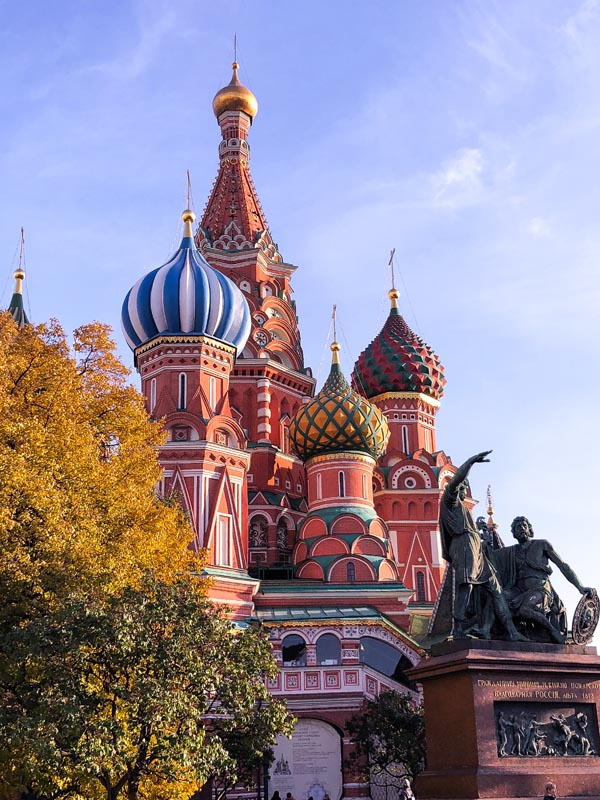
No place tells the story of Moscow’s power in the past century the way the Red Square does. This is where the biggest political meetings in the USSR occurred for many decades, and you can feel the power on each step.
Here, you’ll also find the historic museum at the entrance, showcasing the decades of history behind this iconic landmark. The Lenin Mausoleum, perhaps the most famous resting place in the world and home to the remains of the former communist leader, is also here.
On one side of the Red Square you’ll find the Kremlin, the fortified complex that now hosts the presidential residence. This is also home to the most iconic of all Moscovite landmarks: St. Basil’s Cathedral, a 16th-century marvel of colors. This is the best spot to take a selfie and show the world you’ve reached the Russian capital!
- Get your Kremlin Skip the Line Tickets and Kremlin tour here.
- Free cancellation up to 24-hours in advance of the tour.
2. Bolshoi Theatre
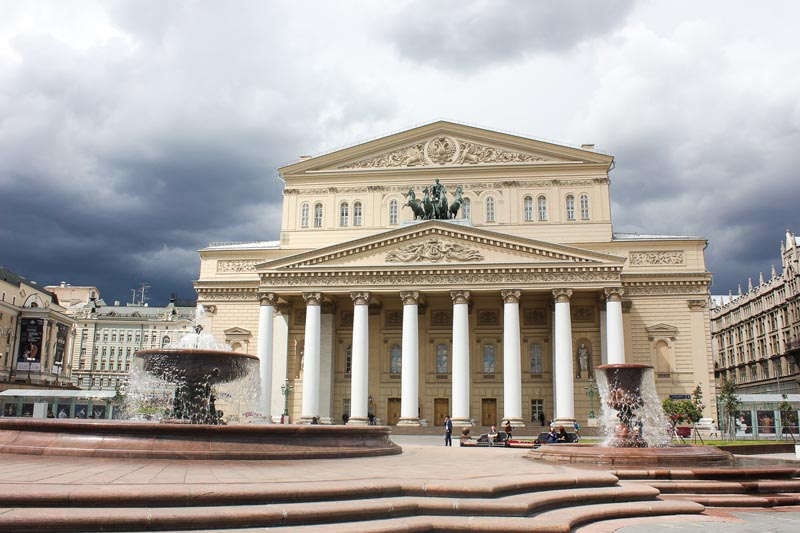
You can easily spend a couple of days just exploring the Moscovite city centre, and the Bolshoi Theatre should be your second stop. Walk past the Red Square and then head to the nearby Bolshoi Theatre, one of the oldest and most renowned houses of opera and ballet on Earth.
Visit for the impressive early 19th-century architecture, but if you’re seeing a ballet performance, make sure you book between 3 and 6 months in advance! I can strongly recommend this as it is a truly unique experience!
- Book a private 2-hour tour of the legendary Bolshoi Theatre.
- See the presidential box reserved for tzars, watch a rehearsal and skip the lines through a separate entrance.
- Free Cancellation up to 24-hours in advance.
3. Luxury Shopping at GUM and TSUM
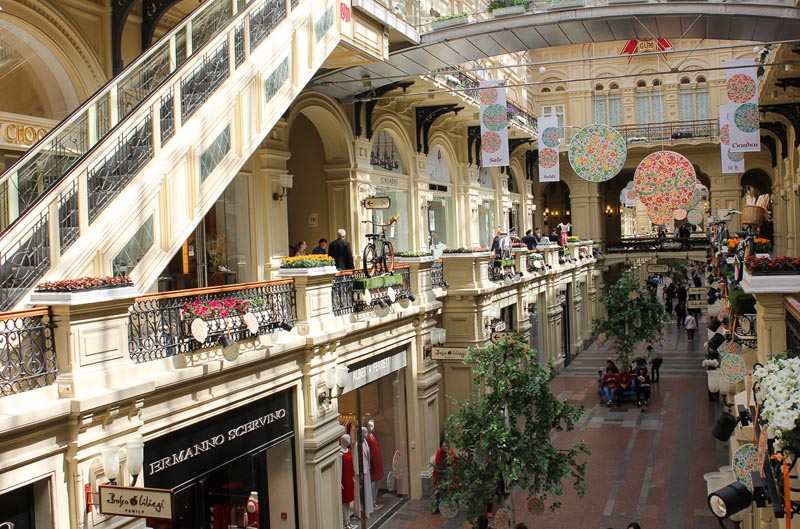
While many might think of Moscow as the sad place with the long bread queues from the USSR days, it’s been quite the capitalist haven for a while.
If you’re up for some shopping, you’ll find one of the biggest luxury malls in town, TSUM, right behind the Bolshoi and GUM, at the red square. GUM is the most famous department store in town, where you’ll find luxury everywhere and all high-end brand.
All in an imposing late 19th-century building with lots of history, worth a visit just for the design, its bridges and the glass roof even though you are not up for shopping!
4. Christ the Savior Cathedral
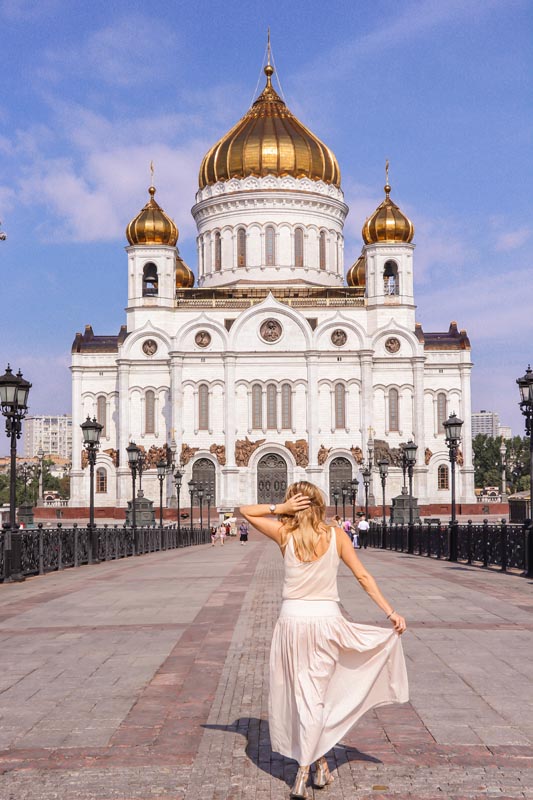
A newer addition to the gorgeous Moscovite cathedrals and my grandeur neighbor during my years in the city Don’t let the young age of this building fool you. After the perestroika in the early 90s, the newly revived Russian Orthodox Church received permission to build a cathedral on this site. They did the location honors and built the largest temple of the Christian Orthodox Church.
The façade is as grand as you’d expect, but it’s the inside that will mesmerize you, with its domes as tall as the skies in bright gold and gorgeous paintings and decor! Bring a shawl to cover your hair to adjust to the local tradition.
Head to the back of the cathedral and you will find one of the most photographed bridges in Moscow, the Patriarshiy Most. This is the perfect spot to get a good view and photo of the cathedral but also to see the Kreml and Gorky Park from a distance. Or why not just enjoy a moment watching the river and its boats!
- Get around Moscow with ease using the Hop On Hop Off boat and Bus ticket. 24, 48 or 72-hour tickets available.
5. Gorky Park
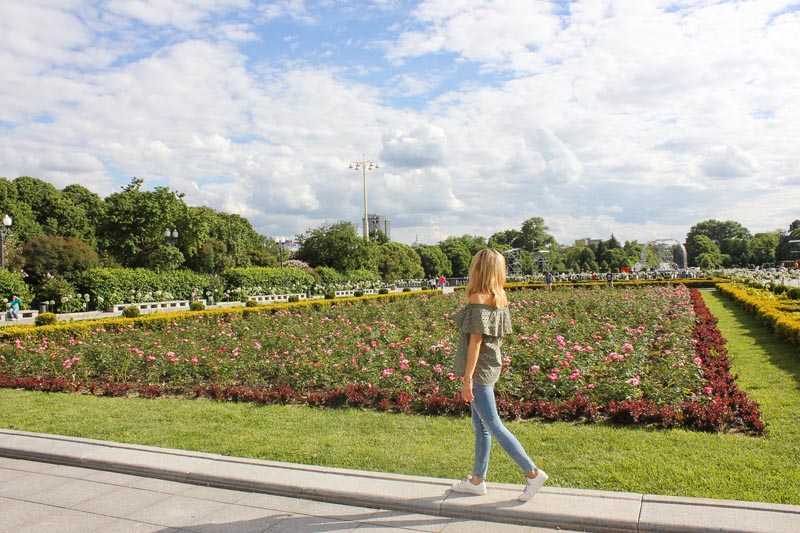
Cross the river and head to Gorky Park along the Moscow river. The most famous green area in town, similar to New York ’s Central Park and the weekend hangout for locals. There are many beautiful parks in the city, but if you’re only visiting for a few days, this is the unmissable one!
With fair attractions to entertain children, beautiful artificial lakes and gardens, and lots of outdoor activities, it’s a lovely place to relax. A place of rest in the middle of the metropolis. The area in front of the New Tretyakov Gallery & the Muzeon Park of Arts is actually one of my favorite oasis as a bit more quiet and peaceful than Gorky itself.
Why not spend some time in the museum to get a great tour of Russia’s history through art or just enjoy the art exhibition outside where local artists spend their weekends.
6. River Cruising
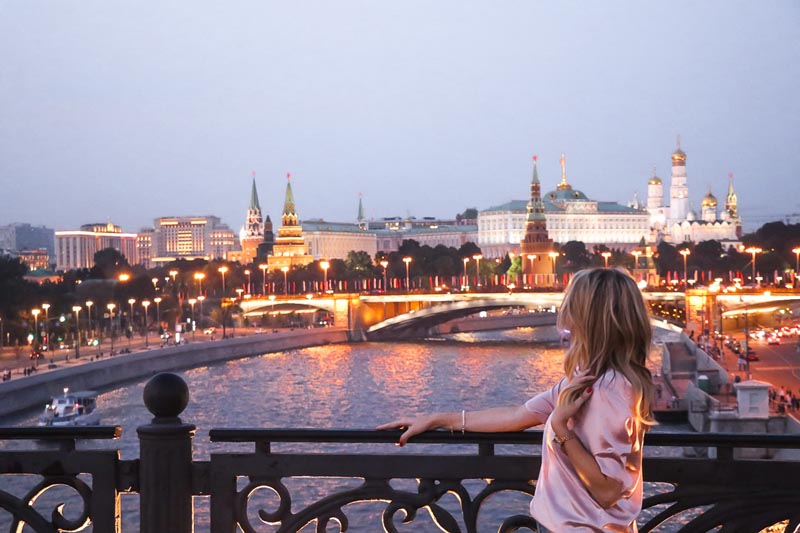
One of the best ways to experience Moscow is from the Moscow River. There are many stops for the boats and one is just next to Gorky Park. See the city from another perspective – and turn the ride into a romantic one by taking the evening cruise. Moscow is magic during the night.
If you’re looking for a truly luxurious experience, take the Radisson Blu cruise – or the Erwin for a delicious seafood dinner. Both stop at Gorky or at the luxury Radisson Royal Hotel, set in one of the Seven Sister’s skyscrapers.
- We use Get Your Guide when booking city tours and they offer a River Sightseeing Cruise seeing all the main tourist attractions in Moscow
7. Metro Hopping
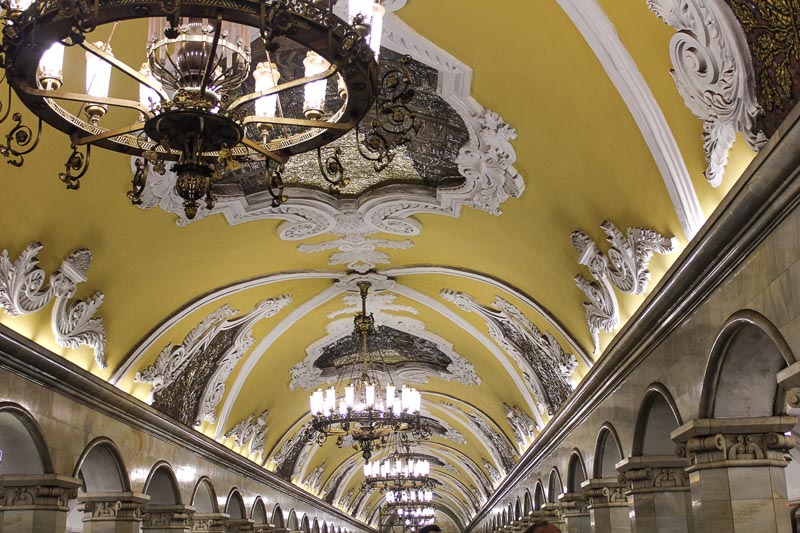
First inaugurated in the 1930s, the Moscow subway system is one of the oldest in the world, and certainly the most beautiful. Started under Stalinist times, each metro station is dedicated to grandeur and oozing personality.
Visiting the subway stops is an attraction in and of itself, and Komsomolskaya, Mayakovskaya, Kropotkinskaya are my favorites. Those surrounding the Red Square are also mesmerizing – in general, these are kind of like underground palaces.
Most of the signs at the Moscow Metro now have Latin letters, so it’s very easy to get around!Unfortunately, the trains are not as beautiful and pleasant as the stations but still, this is a true Moscow experience. Take a guided tour of the 9 most beautiful Metro Stations including the award-winning art deco station. See more details here.
8. Arbatskaya & Artsy Moscow
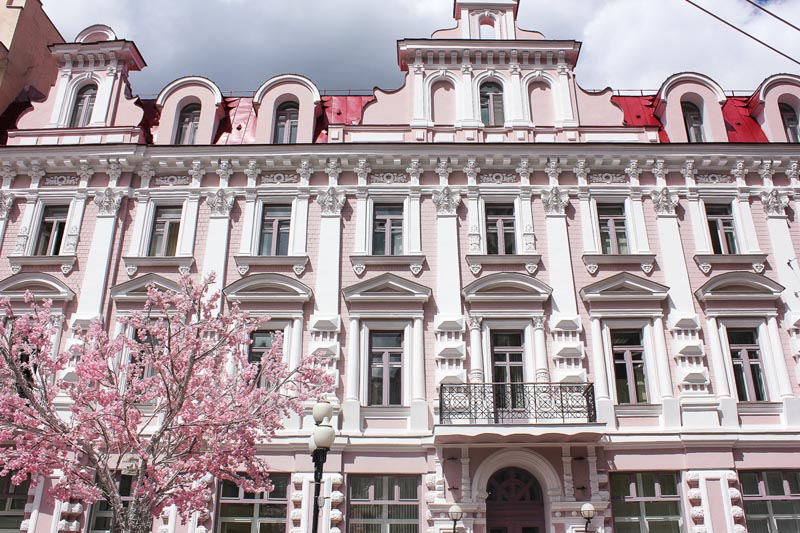
Novy Arbat Street is one of the most touristy areas in the city, with lots of shops and cafés directed at visitors. When you walk a little beyond, you’ll find a different part of town, where the hip scene thrives because so many artists live in the area. Just follow the small streets with fewer tourists!
9. Moscow State University View
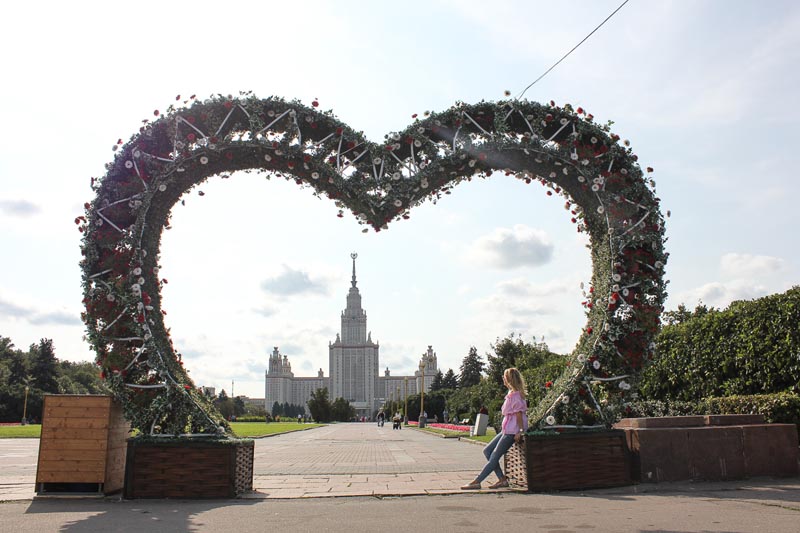
In his effort to create a grander Moscow, Stalin had seven skyscrapers built in different parts of town; they’re called the Seven Sisters. The largest of these buildings hosts the main building of the Moscow State University, one of the most prestigious colleges in Russia – and the one with the best view.
Although this is a little outside the city centre, the sight from above is more than worth it, with the nearby fountains and park and then the whole of the city behind them.
10. Russian Market
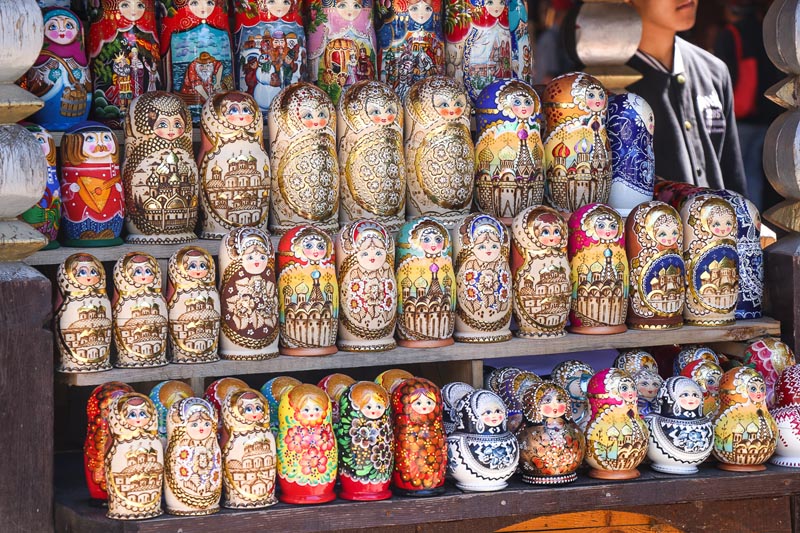
If you love to visit markets wherever you go, Moscow has one of the most impressive ones in the world – the Izmailovsky. You can easily take the metro here and feel like you’ve been transported to another time.
This place was first built in the 16th century and retains the look of an old fairytale, with a lineup of colorful old castle. A lovely local experience beyond the confines of the bustling metropolis, where you can also try some delicious Russian barbecue.
Here, you’ll find beautiful souvenirs at great prices.
Off The Beaten Track Moscow
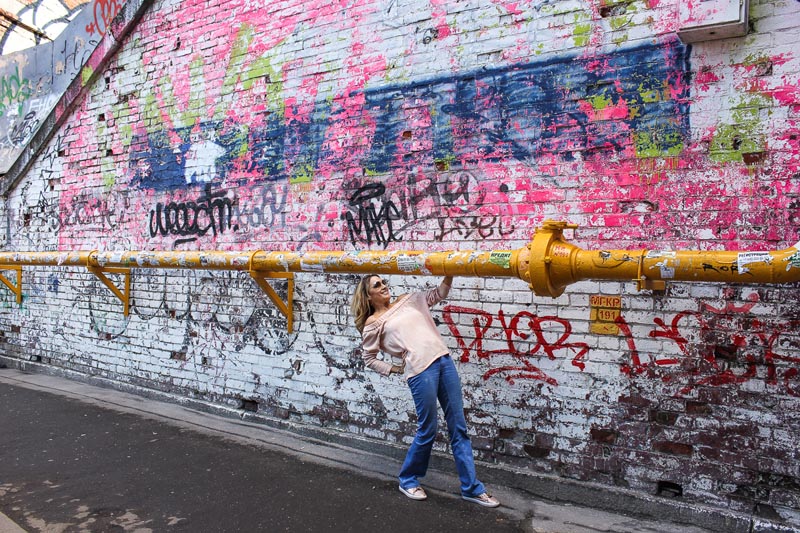
Once you’ve covered the most touristic spots, Moscow still has plenty to offer – and the places below will also be full of locals! Moscow is a city for hipsters, full of trendy and arty spots where you can literally feel the creativity oozing! So for some local vibes, I would strongly recommend my sweat spots below!
11. Patriarshiye Prudy
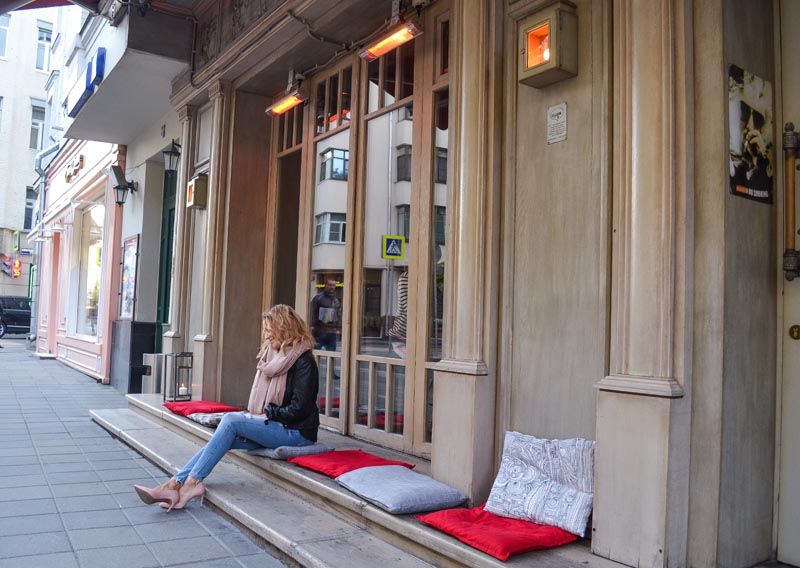
This is my favorite area in the entire city! While Moscow is generally a very noisy metropolis, Patriarch Ponds is far quieter, yet such a vibrant place. This is a very hip and trendy area making you think you are rather in Paris than in Moscow. Here the streets are narrow and full of chic eateries and clubs to see the local crowd.
A little bohemian and with an air of peace you won’t find anywhere in the city this is a great spot to spend an afternoon with your thoughts.
12. ArtPlay
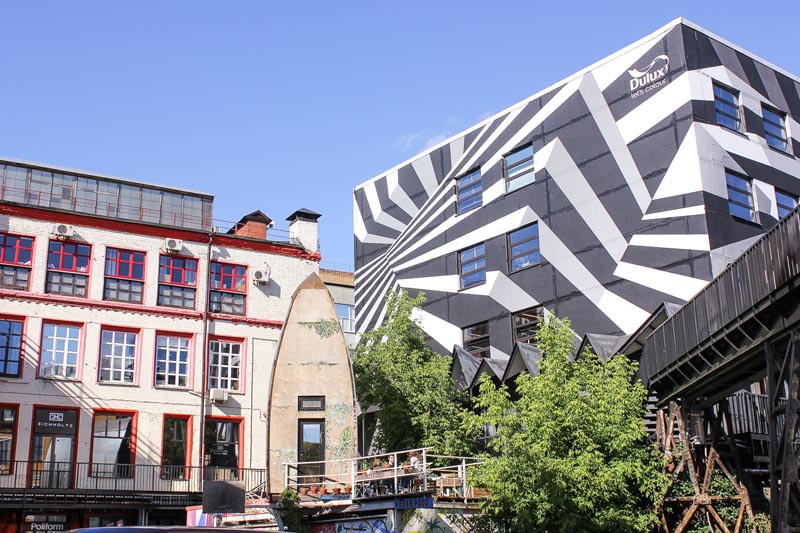
Barely 15 minutes away from the city center you’ll find the artsiest Moscow district: ArtPlay. For decades, this block was a factory, but it was renovated to become a hub for the arts not too long ago.
Now, you’ll find it’s full of exhibitions, showrooms and art schools – and some of the most creative people in town. Writers, painters, and young hip people use ArtPlay as a rendezvous, and you can feel the creative energy here. The industrial design with modern interior decoration is also a feast for the eyes!
13. Shopping Local Designs
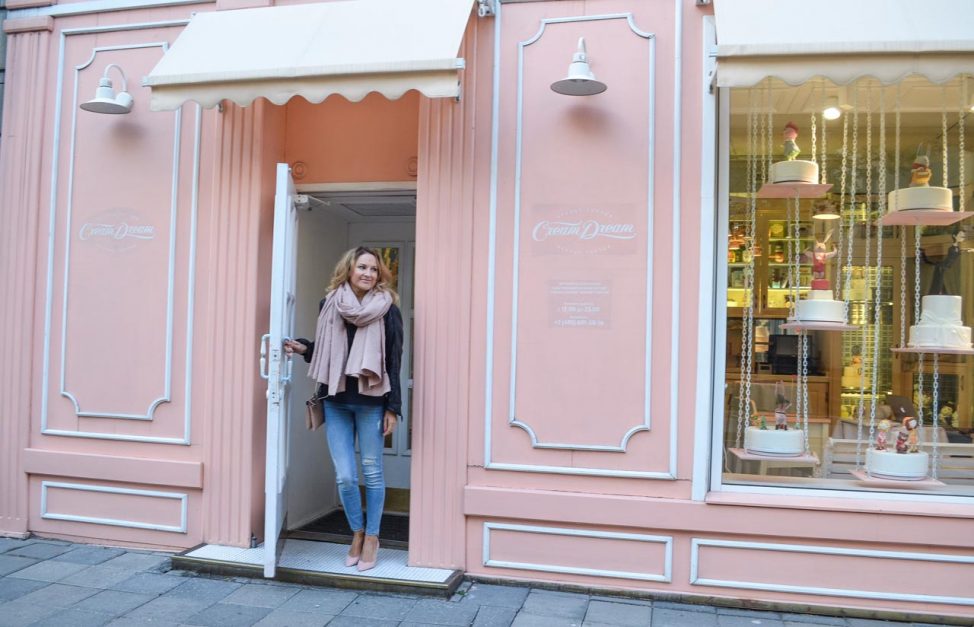
If you’re into design, both international and local, you’ll find lots of cute things at Patriarshiye Prudy. Department store Podium Market is also a great spot for shopping, as a department store everywhere in town, with lots of local and international brands. There’s one in the Four Seasons Hotel next to Red Square. My favorite Moscow mall is Tsvetnoy Central Market, a cool spot with great brands, lots of inspo, and even a cute café!
14. Moscow City
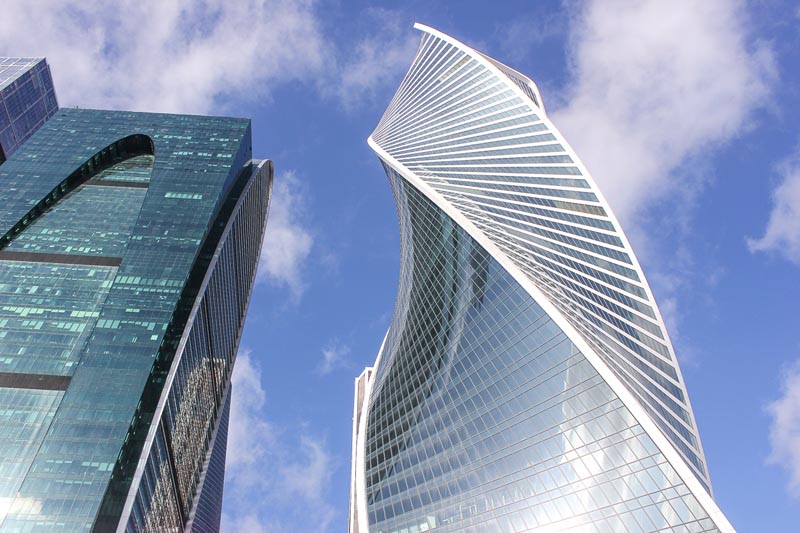
Like many other great capitals of the world, for the past few decades, Moscow has hosted a super modern area full of modern skyscrapers – Moscow City. With a completely different vibe than the rest of town, it’s like a mini Dubai, with lots of impressively tall glass buildings. Here, you’ll find the best rooftops in towns, such as Ruski and Sixty they are perfect spots for dining or enjoying a glass of wine with a view. There are also a relatively new shopping mall with lots of international brands called Affimall!
Wine, Dine, and Party in Moscow
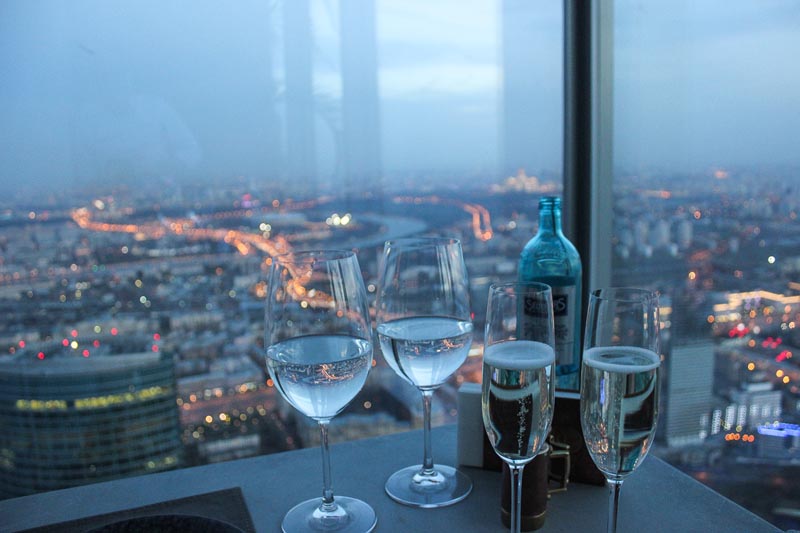
Gone are the gloomy Moscow days – cold as it might be in the winter, Russia’s capital is a place for the senses. Great food and drinks abound – and the clubs are hot, too!
15. Where to Eat in Moscow
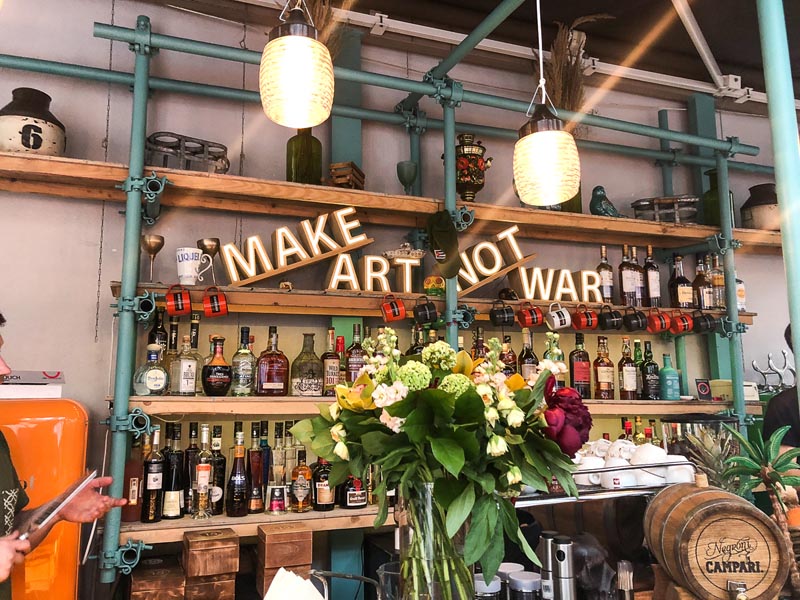
Moscow is a great metropolis where people love to dine out, and there are endless options for delicious food. The flavors are as diverse as you’d expect from a big city, with options of fine dining and little hipster eateries.
- For traditional Russian flavors, I can’t recommend Café Pushkin, Dr. Zhivago, and Turnadot enough.
- When looking for international cuisines, Italian is always the way to go, and my local favorite is Probka.
- Fine dining is best done among the clouds at White Rabbit, with European flavors.
- As for the hip spots, you can spend a full day just eating around trendy places, from burgers to Asian fusion.
More Dining Options
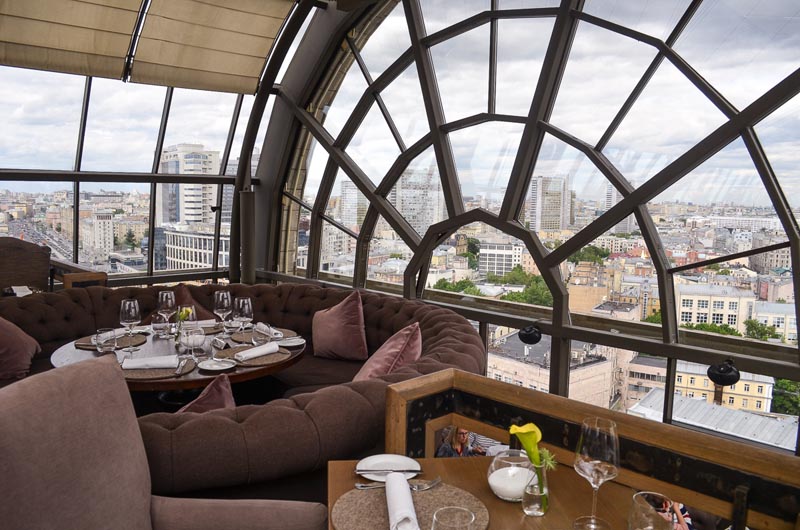
- Patriarshiye Prudy offers a lot of small and classy spots with cool concepts, like breakfast restaurants I Love Cake and Fresh.
- For dinner, I love the NYC experience of Saxon & Parole, and the wonderful trendy Pins, with its delicious food and drinks.
- For delicious Asian food head to CutFish.
- Lastly, there’s a recent revival of food markets in Moscow, offering lots of great choices of international flavors at affordable places.
- Don’t miss out the Vietnamese food stand at the Danilovsky market, and everything at Usachevsky!
16. Rooftopping
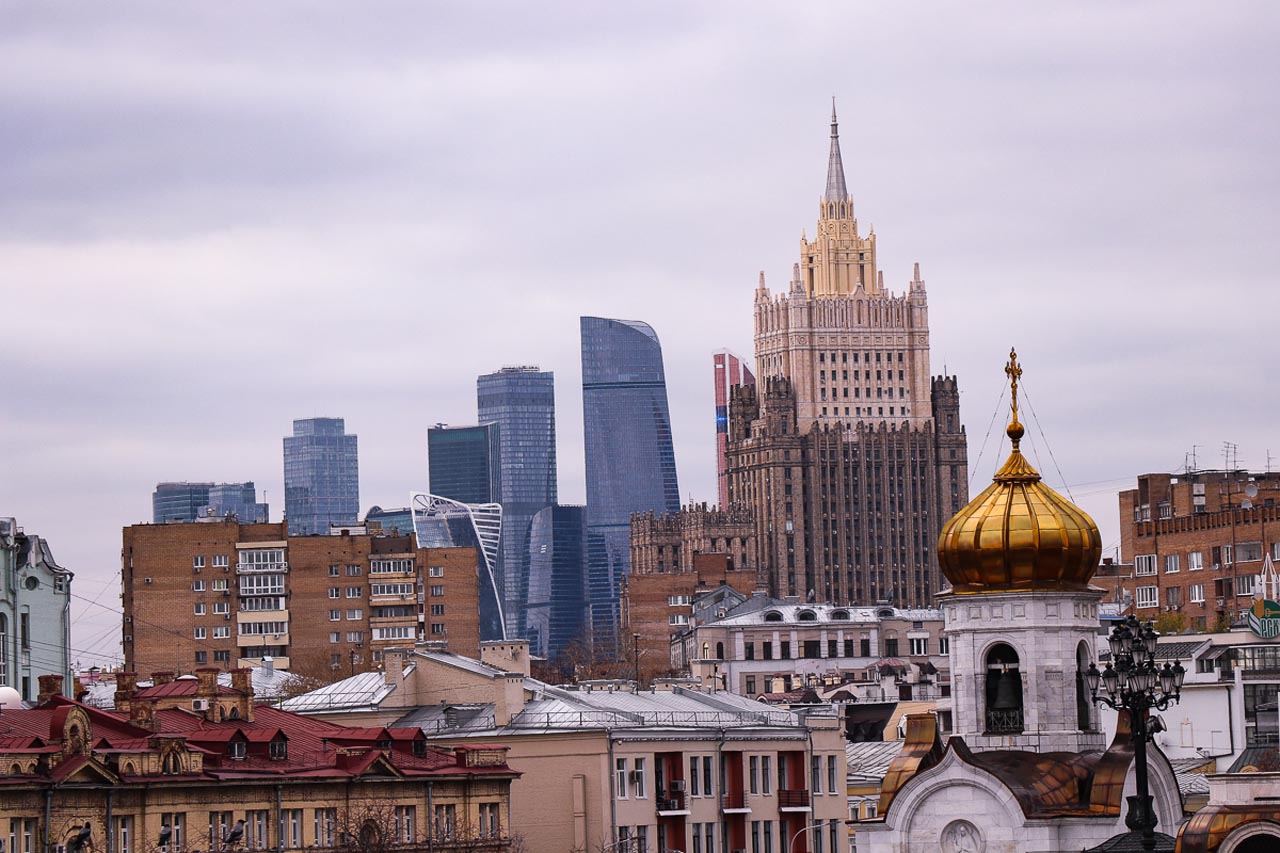
Big cities deserve to be seen from above, having a cocktail among the clouds. These are my recommendations for rooftop bars in Moscow.
- As I mentioned in the Moscow City section, Sixty & Ruski are two of my favorites, overlooking the newest part of town.
- White Rabbit and its fine dining is also a lovely place for a fun dinner looking down on Moscow.
- O2, in the city center, has an advantage above all others: amazing views of the Red Square.
- Buono, above the Radisson Royal Hotel, might be the most romantic rooftop hotel in town, with its candlelit setting.
- Also on the Radisson stands the Mercedes. It’s a luxurious and posh experience with delicious cocktails.
- The Sky Lounge offers a peculiar experience, mixing an old Soviet building with futuristic additions.
17. Moscow by Night
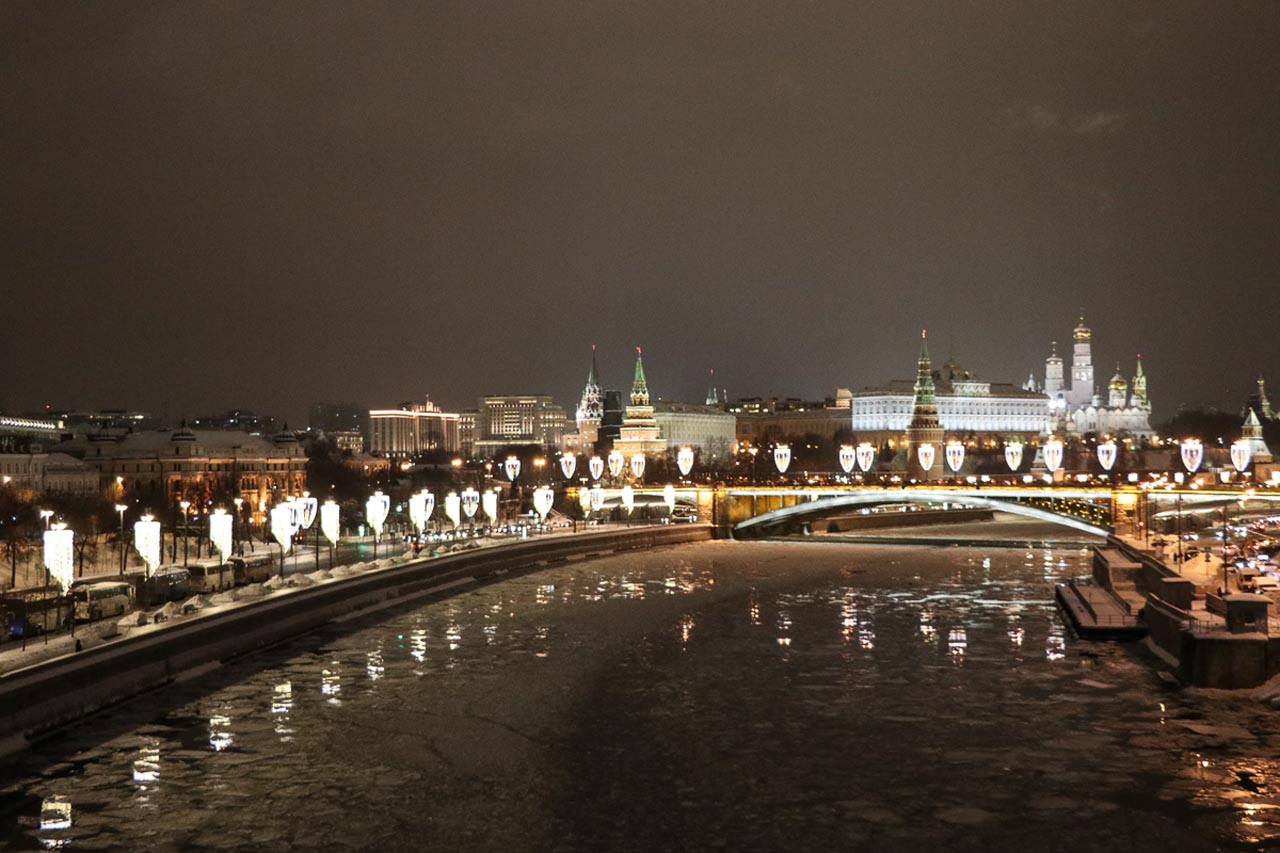
Party the night away! The city is full of bars everywhere, but there are some areas where you’ll find more than others.
- Patriarshiye Prudy has lots of hip and small clubs and great bars, including the super fun private club Clava, which has a great vibe and people from all walks of life.
- For more hipster style bars, Red October is the place to go.
- Streak is a summer favorite, with a lovely terrace to catch a beautiful sunset – plus, their mozzarella bar is delicious.
- At night, Red October lights up with clubs everywhere, including the cool rooftop one Gipsy.
- Jagger is also a great spot during summer with a more relaxed vibe in garden setting.
- For the traditional Russian luxury experience, go to SohoRooms, a whole other world including all-night go-go dancers.
There are so many things to do in Moscow at night and during the day, you definitely need several days to explore this exciting destination.
Moscow is a must-see city, a city like no other ! I hope you will enjoy this Russian metropolis as much as I did!
If you enjoyed this article on the , share it to Pinterest for future travel planning.
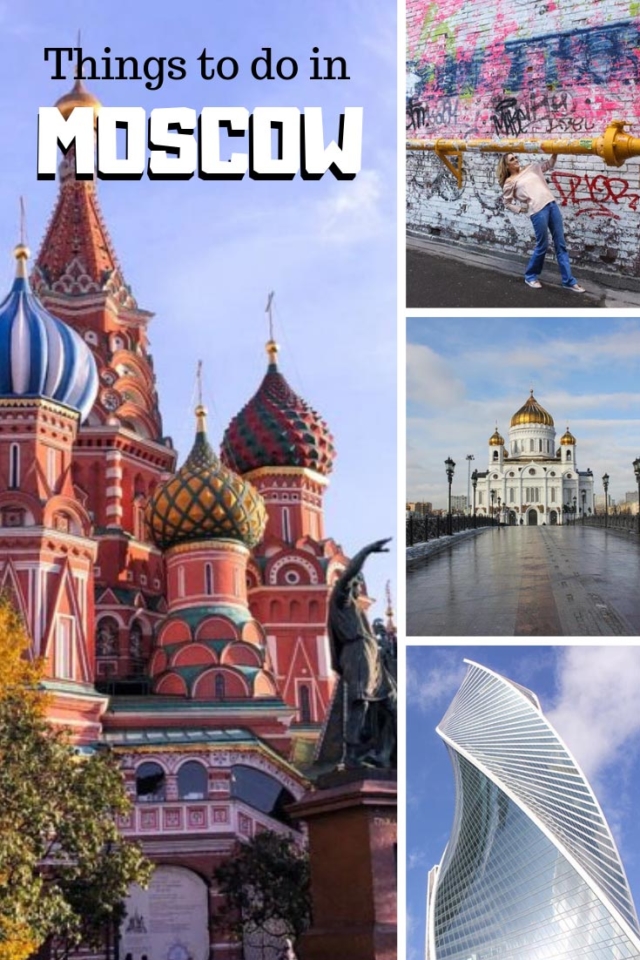
- Mother Russia Stands Proud at Volgograd
- 25 Haunting Chernobyl Pictures – 3 Decades after the Disaster
- 10 Reasons to Add Tbilisi Georgia to Your Bucket List
Follow Linda on Instagram guides! For more inspiration, follow my journey also on Facebook and Pinterest and see Linda’s bio below for more at her website.
Travel Planning Resources
Looking to book your next trip? Why not use these resources that are tried and tested by yours truly.
Flights: Start planning your trip by finding the best flight deals on Skyscanner
Book your Hotel: Find the best prices on hotels with these two providers. If you are located in Europe use Booking.com and if you are anywhere else use TripAdvisor
Find Apartment Rentals: You will find the cheapest prices on apartment rentals with VRBO .
Travel Insurance: Don't leave home without it. Here is what we recommend:
- Allianz - Occasional Travelers.
- Medjet - Global air medical transport and travel security.
Need more help planning your trip? Make sure to check out our Resources Page where we highlight all the great companies that we trust when we are traveling.
You May Also Like

16 Interesting and Surprising Facts About Russia
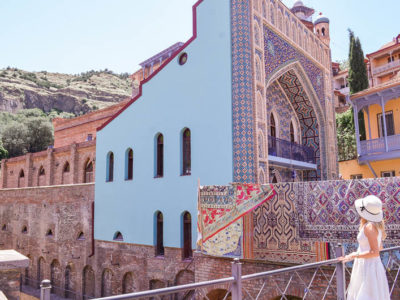
12 Beautiful Reasons to Visit Tbilisi, Georgia
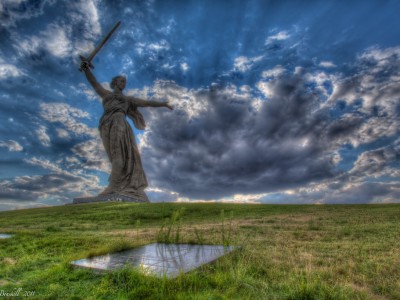
Motherland Calls – Mother Russia Stands Proud Over Volgograd
About Linda Voltaire
Linda Voltaire is the owner of Travel with a Silver Lining, home to reviews of gorgeous boutique & design hotels, hip & trendy eateries as well as authentic and personal travel experiences beyond the crowd. She started blogging after a life-changing trip across South America. Follow Linda at TravelWithASilverLining / Facebook / Instagram /
Join thousands of others who get our monthly updates!
Leave a comment cancel reply.
Save my name, email, and website in this browser for the next time I comment.
10 thoughts on “17 Exciting Things to do in Moscow”
These places look so awesome! Moscow is truly a beautiful city
Very good article, you have explained so nicely. Russia has always been a part of history and its good to know about much more about architecture and other things, wish i could see the inside of façade
Thanks for sharing such a nice article.You have very beautifully explained everything that one need for a trip to Moscow.
Nice article. Love the hidden gems and graffiti art, would love to visit Artplay. Thanks for a comprehensive guide to Moscow!
Moscow is a city where the past and the future live side by side. Here we can find everything from medieval fortresses and Soviet monoliths to glass skyscrapers and innovation centers.
Your article is good and meaningful .
Thanks for sharing about ArtPlay district, we didn’t know about it and it looks amazing 🙂 Hopefully there’ll be a second time in Moscow, we visited last May and really liked the city!
Wonderful stuff! I’ve been to Moscow, but not properly – it’s a long story lol!
Anyhoo, my next thing is to fly from Berlin to Moscow and then travel from there to Beijing via the Trans-Mongolian / Trans-Siberian train. Now, if only I could just find the time …!
I hear Moscow is very beautiful at night. I hope to get out there one day. A friend of mine went to St. Petersburg and had a great experience. Despite all the tension we see on the news with Russia and other Countries like the U.S. I wonder what the sentiment is with Russians and foreigners visiting their country for tourism. Especially Americans.
that looks like quite a beautiful place. 🙂

IMAGES
VIDEO
COMMENTS
JOURNEY, noun. A set amount of travelling, seen as a single unit; a discrete trip, a voyage.
In order to retrieve the list of associations to a word, just type in the word in the search panel and press <Enter> key or "Search" button. It is also possible to search for a word by the first letter. Click the desired letter on the navigation pane, and you will pass to a page containing a list of words, which start with the given letter.
word association statistics for "journey" "journey" statistics. word rank: 2/10
Journey Words. Below is a massive list of journey words - that is, words related to journey. The top 4 are: travel, trip, story and trek. You can get the definition (s) of a word in the list below by tapping the question-mark icon next to it. The words at the top of the list are the ones most associated with journey, and as you go down the ...
Abstract. Word associations have been the topic of intensive study in psychology as they offer one of the most direct ways to learn about the mental lexicon. This chapter provides an overview of the role of word associations in psycholinguistic research. The first part explains what associative responses are, how they relate to lexical ...
Word Association Game - A Word Journey with Example. Word Association is a word game where participants take turns sharing words or phrases that are related in some way to the word or phrase mentioned before them. These connections can be based on similarities in meaning, associations, or personal experiences. ...
Jungian Therapy. Jungian therapy, sometimes known as Jungian analysis, is an in-depth, analytical form of talk therapy designed to bring together the conscious and unconscious parts of the mind to ...
This chain of associations can continue, linking one word to another, and creating a rich tapestry of interconnected ideas. One great way to use word association exercises is for event planning. Whether you are organizing a conference, workshop, or social gathering, word clouds can be a powerful tool to engage and captivate attendees.
Last week we started using the Level 1 WASP (Word Associations for Syllable Perception) pictures for the same purpose, to help Lily discover the connection between what she hears and what she is able to say. These pictures represent the full range of the English language, vary by pitch, duration and intonation patterns and by number of syllables.
Word Association Test Examples PDF For SSB [500+ W+ - Free download as PDF File (.pdf), Text File (.txt) or read online for free.
Together with his colleague Franz Riklin, in 1904, he therefore developed what he took to be a more reliable technique which he termed the Word Association Test. In this, doctor and patient were to sit facing one another and the doctor would read out a list of one hundred words. On hearing each of these, the patient was to say the first thing ...
We've compiled all the words related to journey and organised them in terms of their relevance and association with journey. ... Below is a massive list of journey words - that is, words related to journey. The top 4 are: travel, trek, trip and excursion. You can get the definition(s) of a word in the list below by tapping the question-mark ...
Pursuing health will take you further, and this book will feature some of the many techniques and tips I have found on my own journey. For those of you who pursue health and healing, do all you can in the physical channels. Being in balance will always be a main factor in true health. Health is like the universe.
2. You're Not Alone. If you are discouraged and feeling the darkness, remember you are not alone. It's normal. And it won't last forever. The sun will rise. The light will come. Darkness will be expelled. Yes, there's lot of joy, adventure and excitement on this association journey.
The third of the Word Journey games follows the rules of the classic word search, save one alteration. You need to find specific words, but the game does not list the words you need to find. It only shows blank spaces at the top of the puzzle. You need to figure out what the words are. To do this, pay attention to the puzzle's theme at the ...
Are Marketing and Membership at Opposite Poles? Take the Journey to Collaboration February 20, 2024; Association 4.0—A Playbook for Success February 13, 2024; For Better Virtual Work Vibes—Try EI February 6, 2024; Digital Empathy Brings Data to Life January 30, 2024; Build a Successful Team, Know Where Your People Thrive January 23, 2024
WORD, a quarterly academic journal of linguistics published online and in print, is the publication of the International Linguistic Association (ILA). Founded in 1943 as the Linguistic Circle of New York, the association became one of the main sources of new ideas in American Linguistics at that time. Its journal WORD was founded in 1945 with a ...
Day 6 - Explore the Golden Ring. Creating the Moscow itinerary may keep you busy for days with the seemingly endless amount of things to do. Visiting the so-called Golden Ring is like stepping back in time. Golden Ring is a "theme route" devised by promotion-minded journalist and writer Yuri Bychkov.
2. Transit visa is valid for 72 hours if travelling by air. The validity is 10 days if you intend a road journey to another country. 3. To apply for a transit visa at the Russian Embassy/Consulate you only need 1) a copy of the visa of the destination country, if at all that is required, 2) DEFINITELY the copy of fight tickets for arriving and departing from airports in Russia.
word association statistics for "journey" "journey" statistics. word rank: 2/10
1: Off-kilter genius at Delicatessen: Brain pâté with kefir butter and young radishes served mezze-style, and the caviar and tartare pizza. Head for Food City. You might think that calling Food City (Фуд Сити), an agriculture depot on the outskirts of Moscow, a "city" would be some kind of hyperbole. It is not.
Although this is a little outside the city centre, the sight from above is more than worth it, with the nearby fountains and park and then the whole of the city behind them. 10. Russian Market. If you love to visit markets wherever you go, Moscow has one of the most impressive ones in the world - the Izmailovsky.